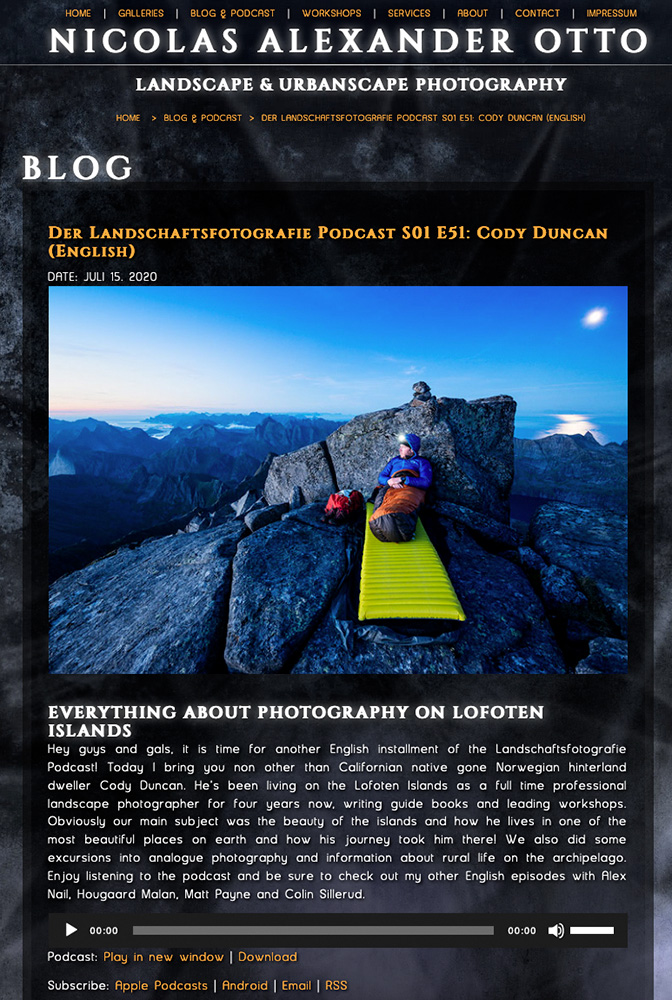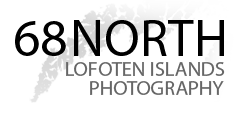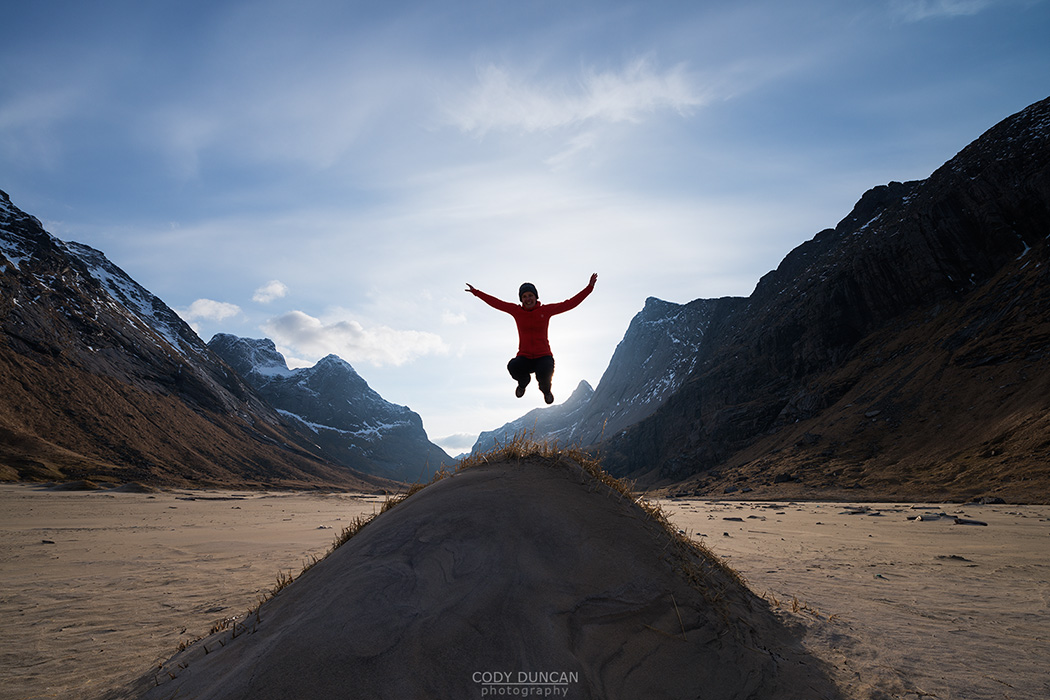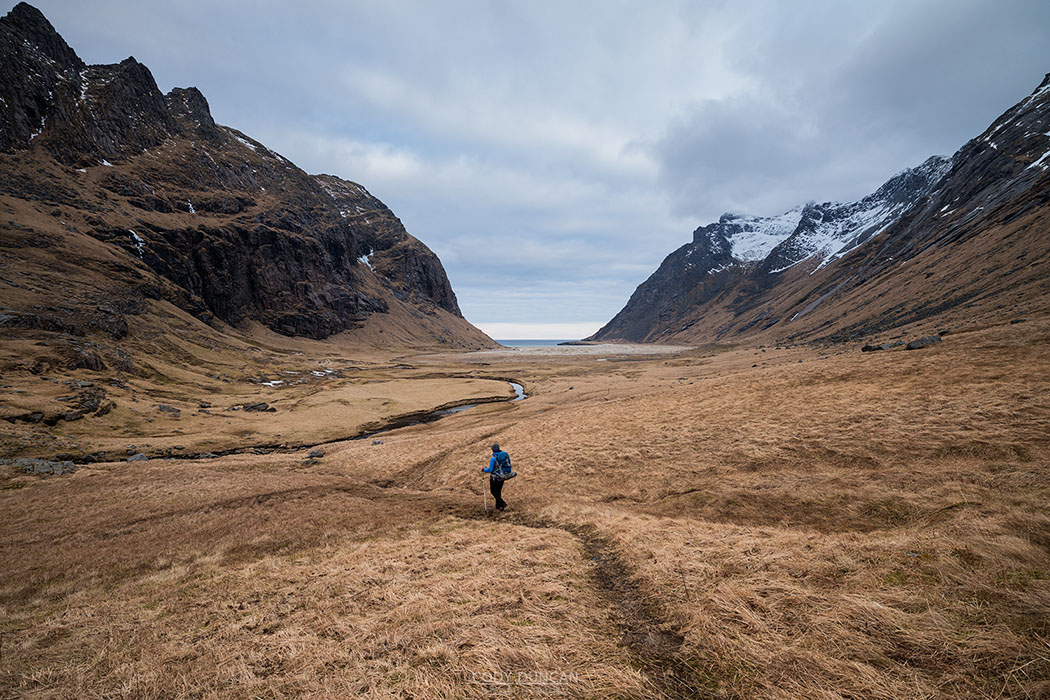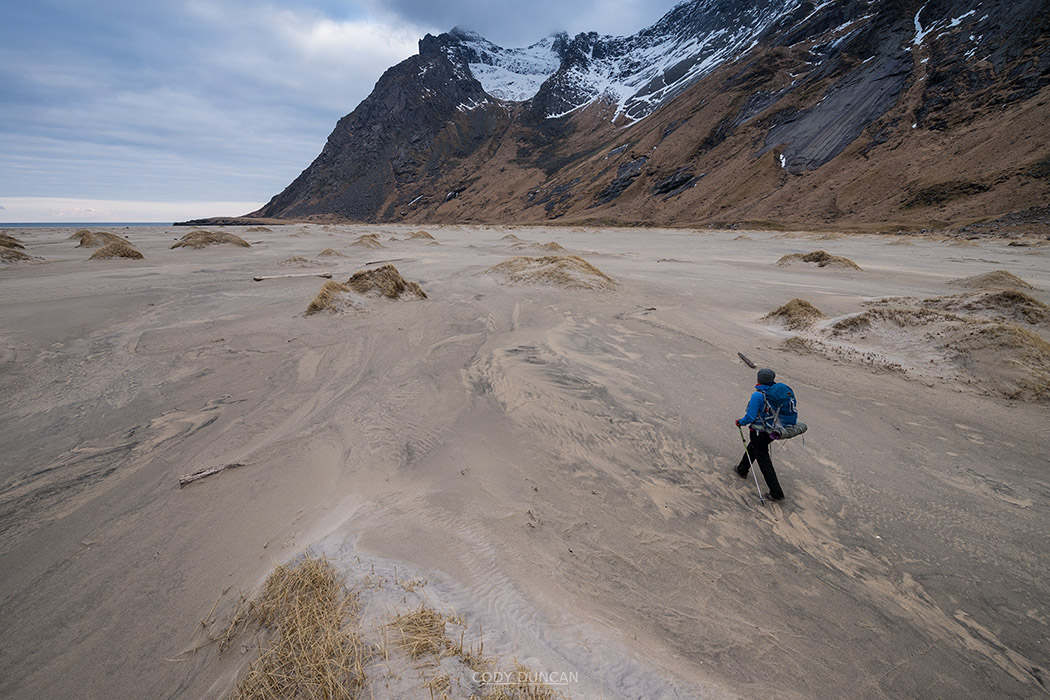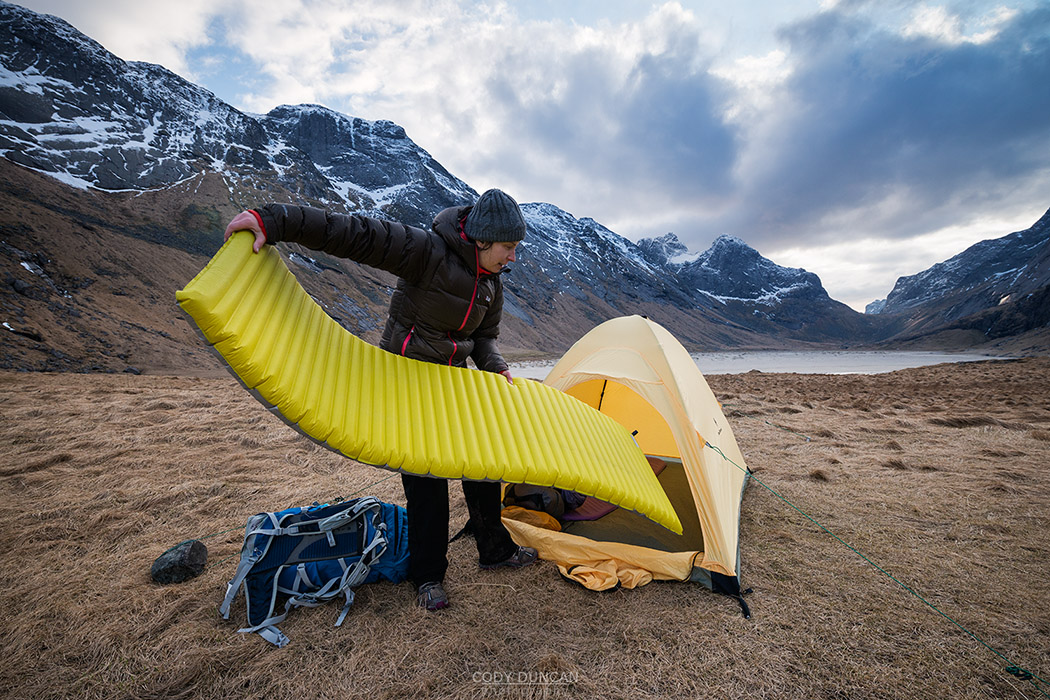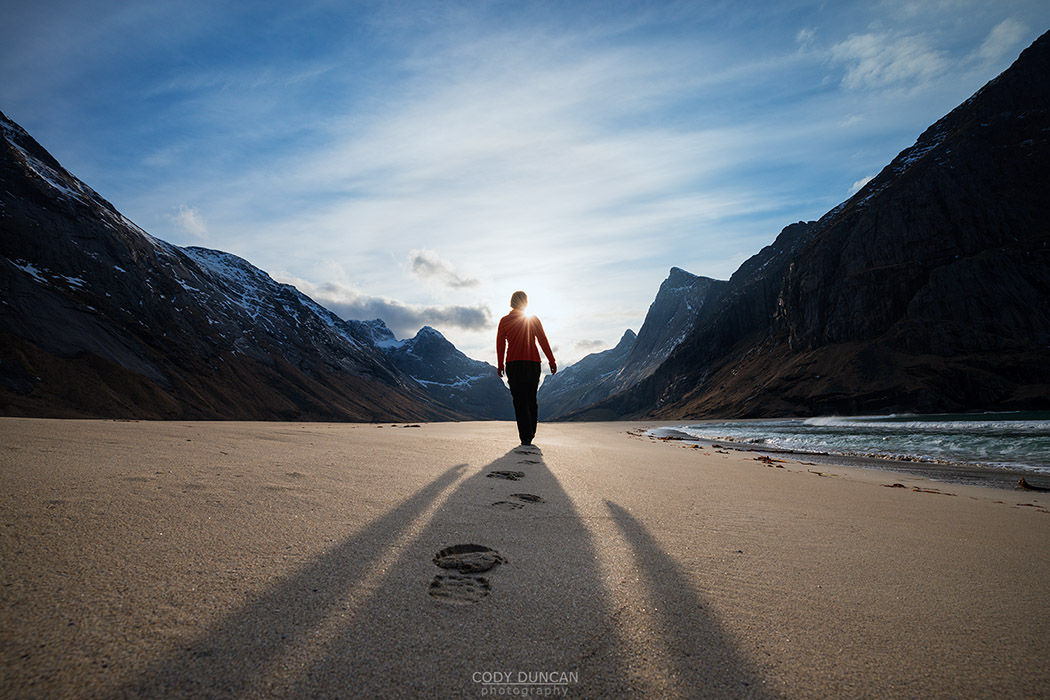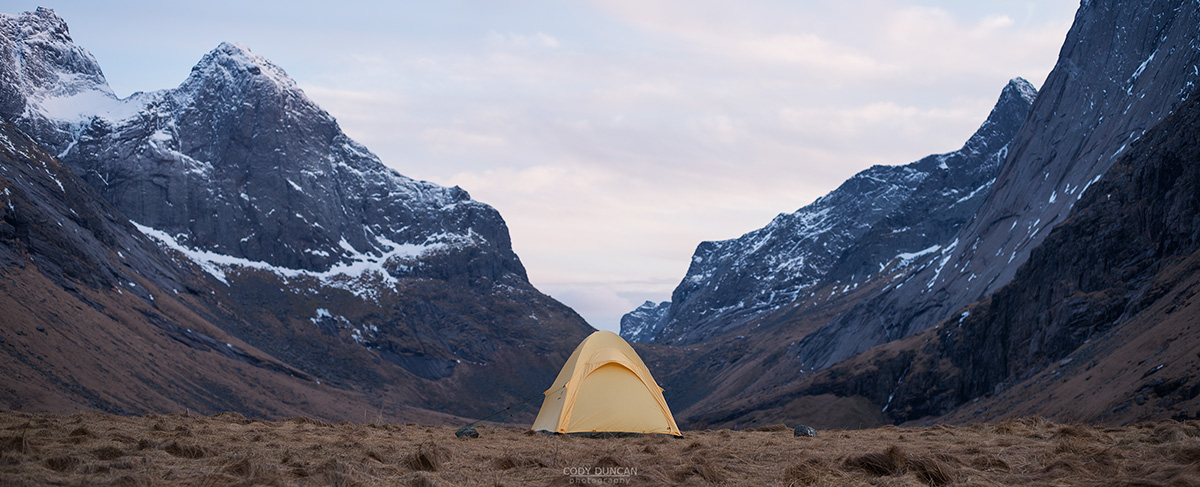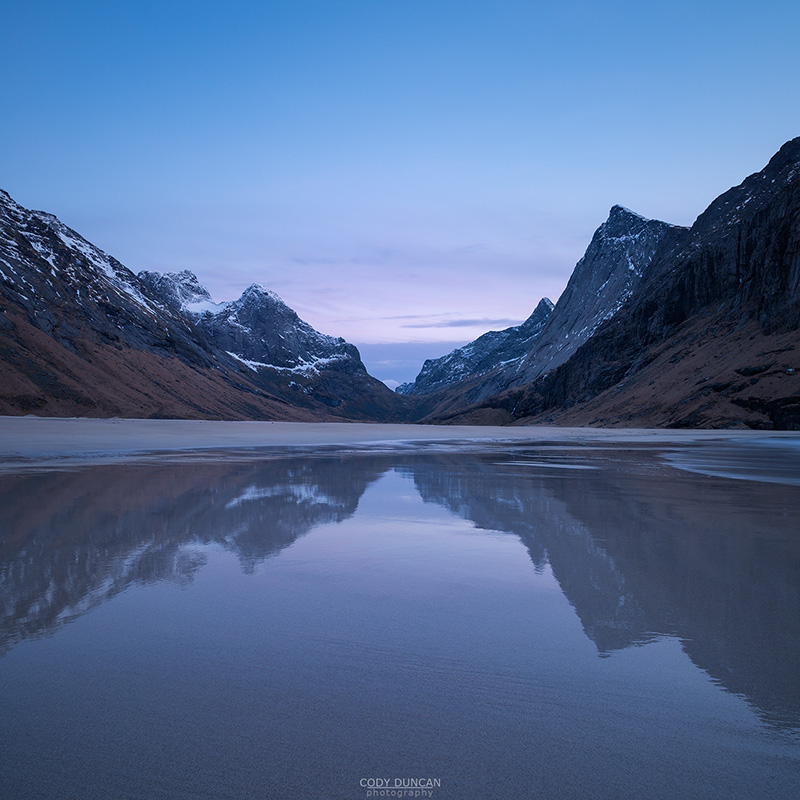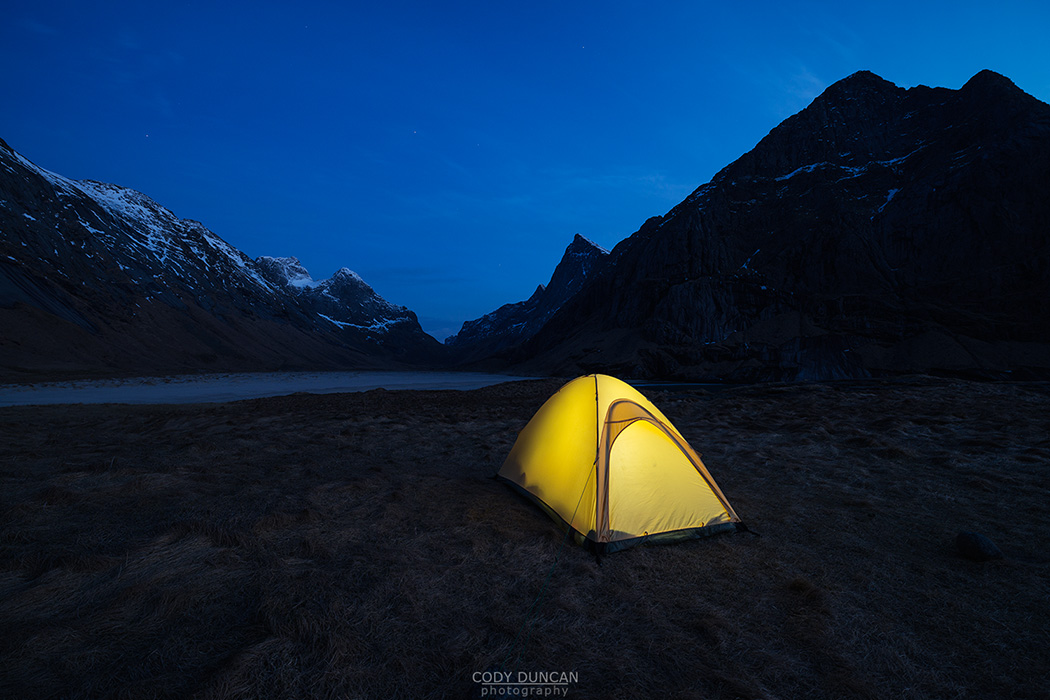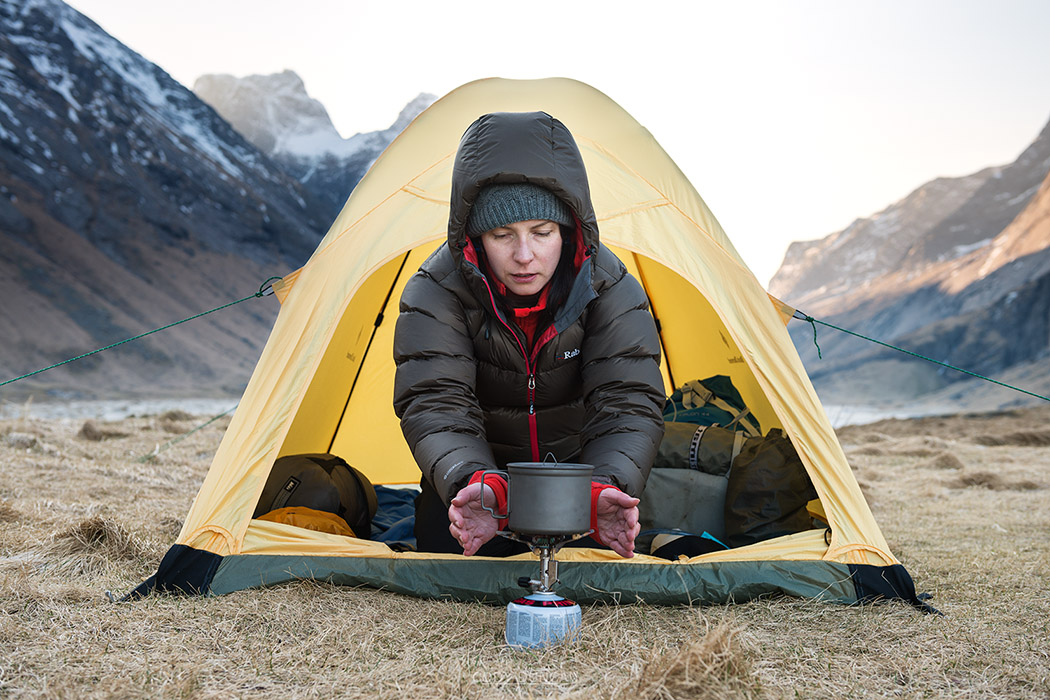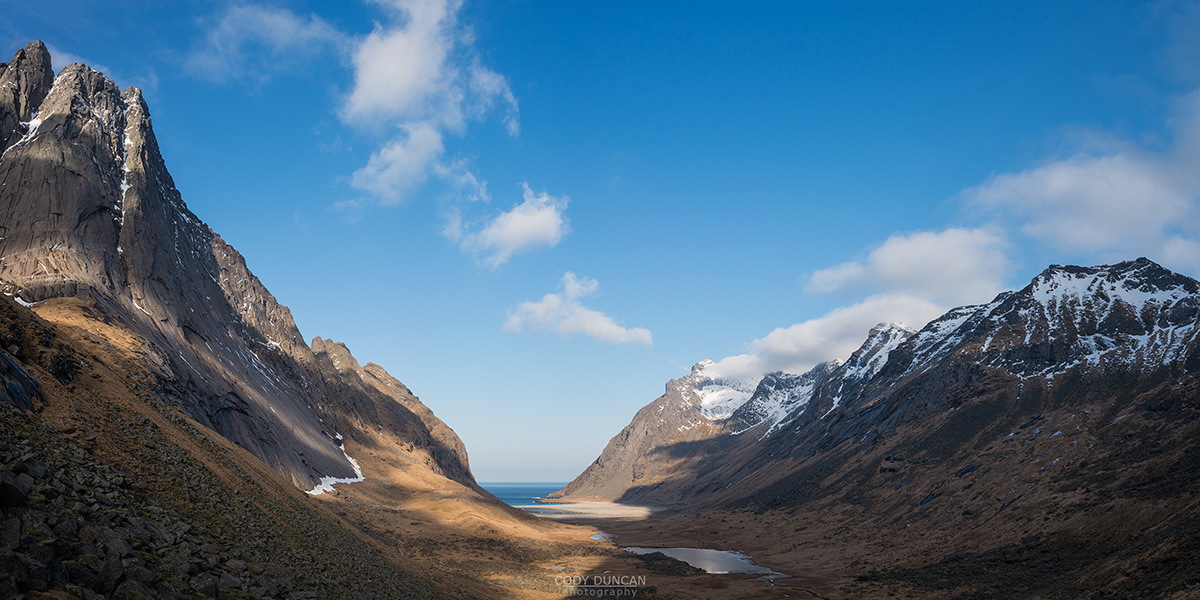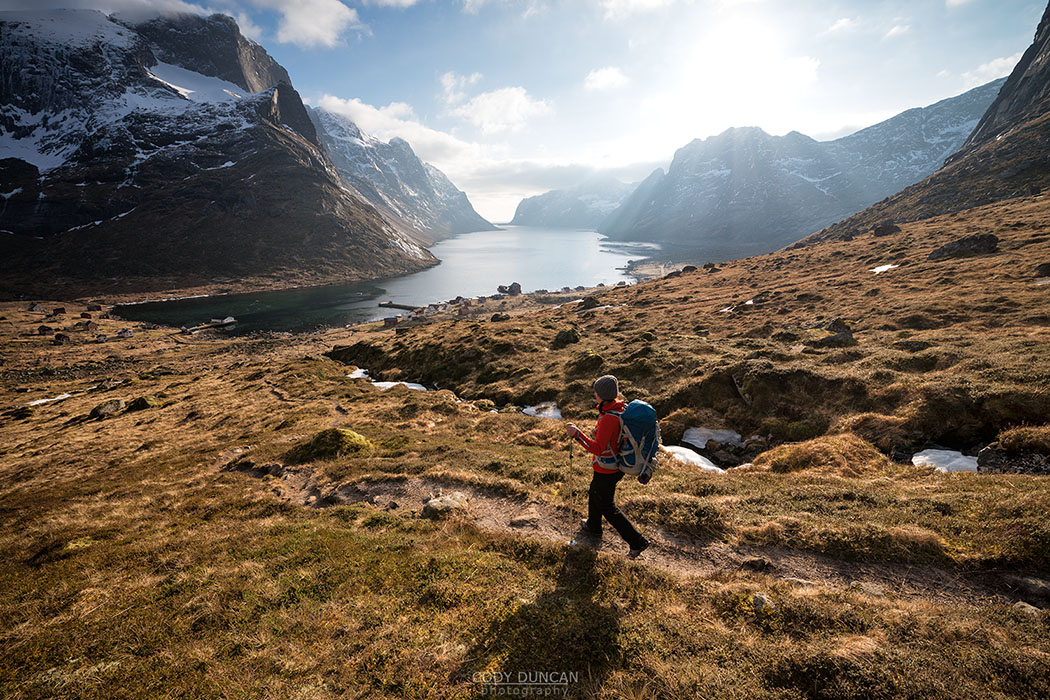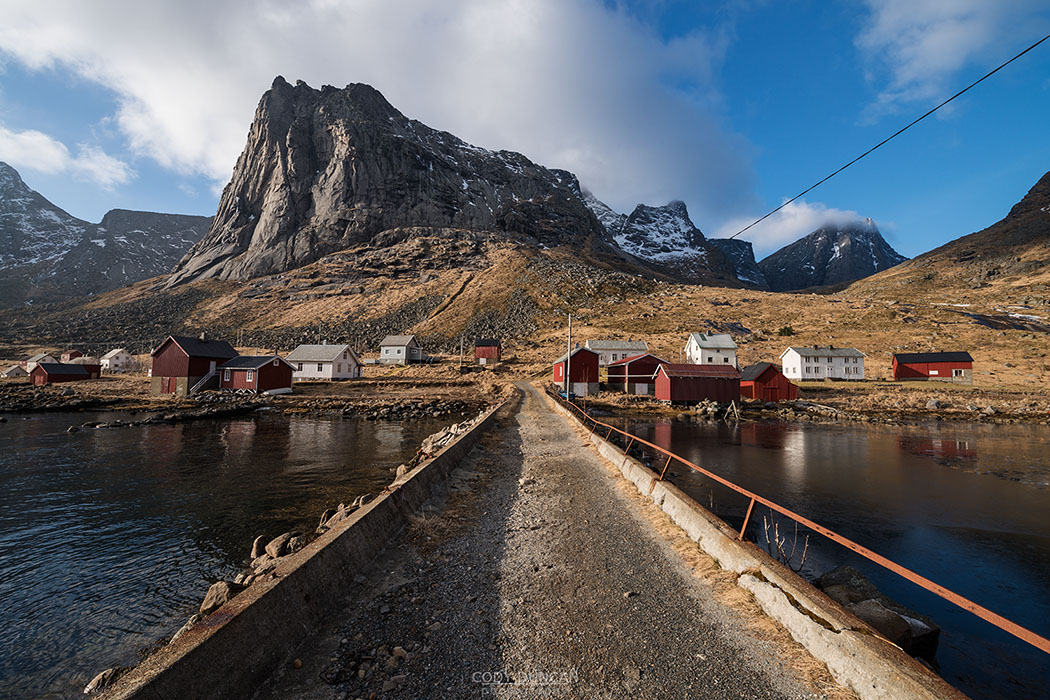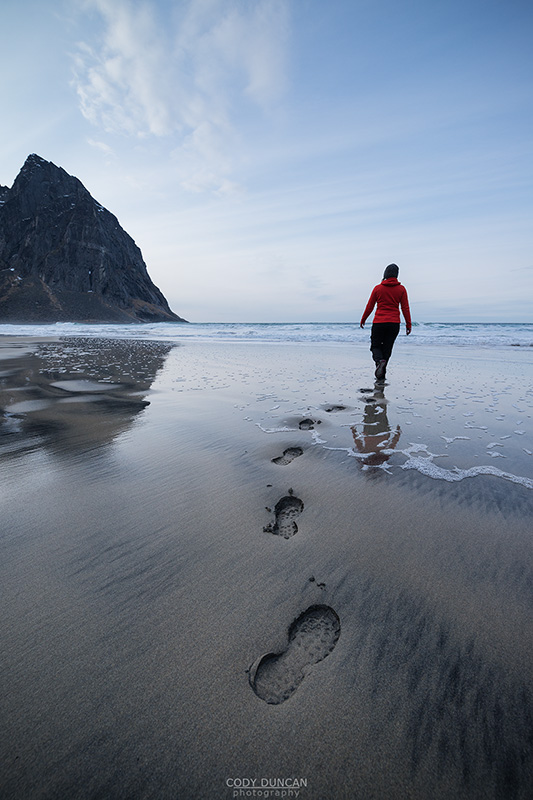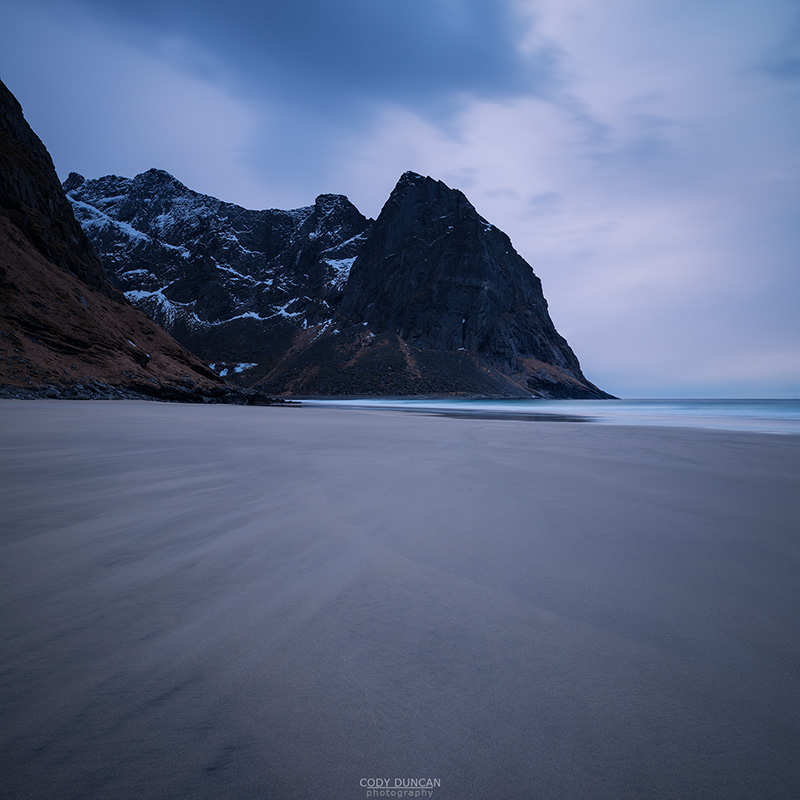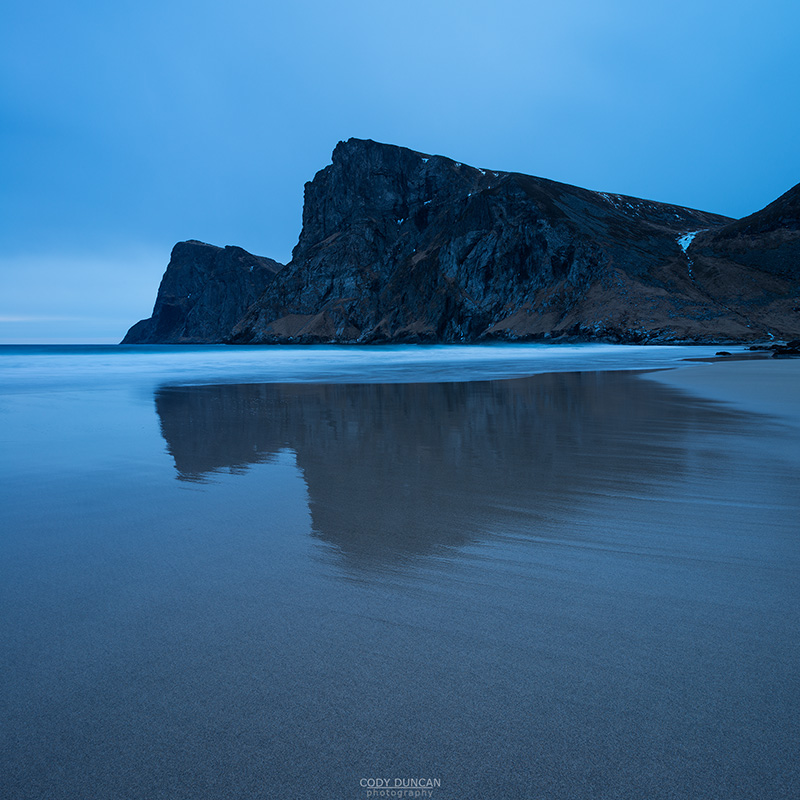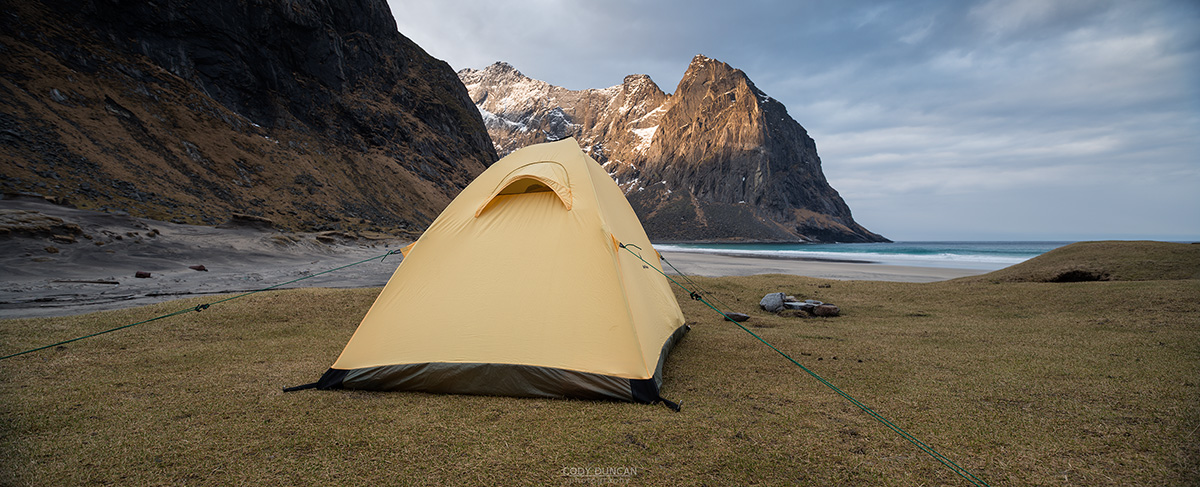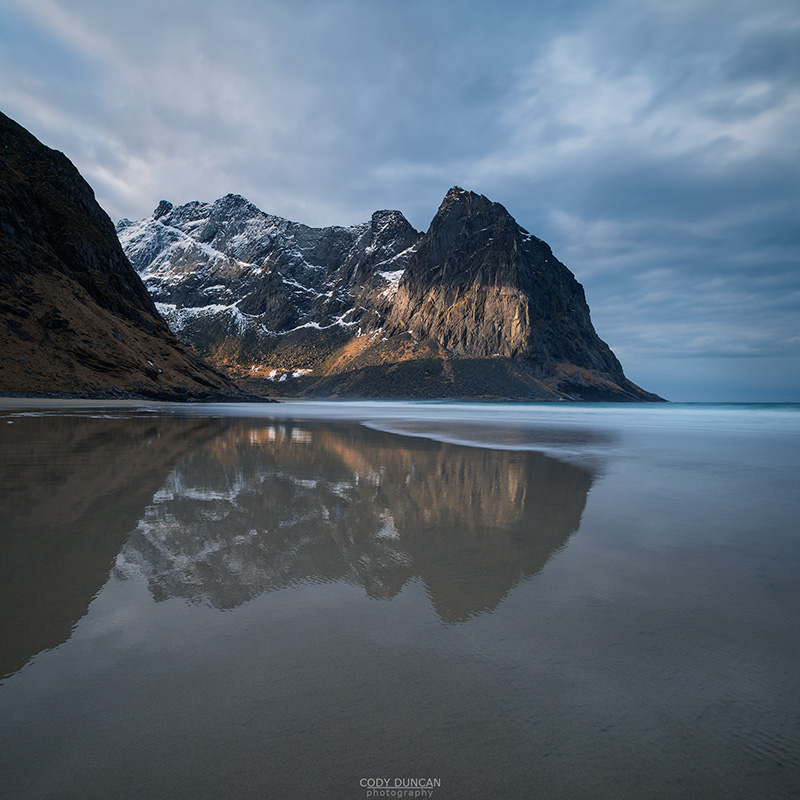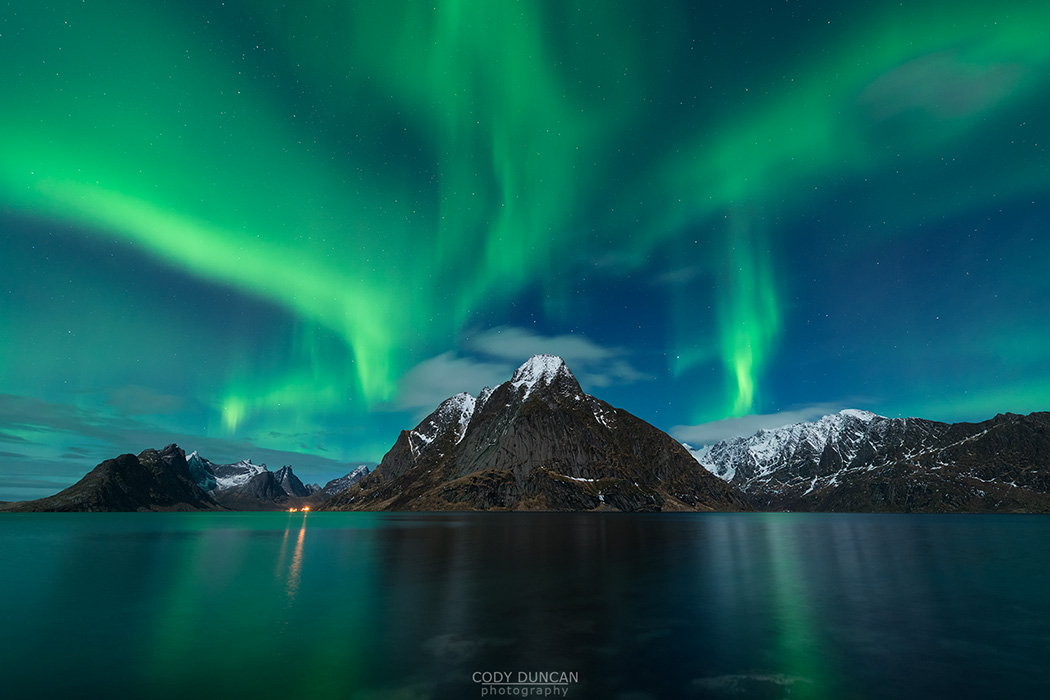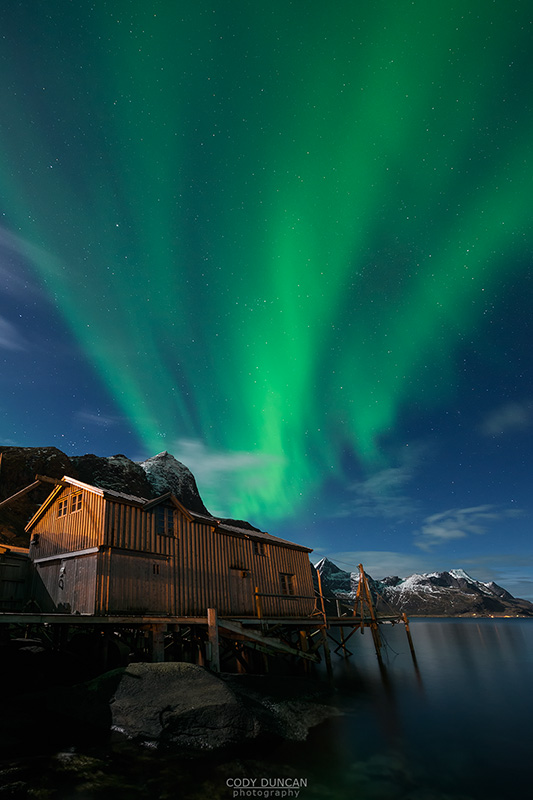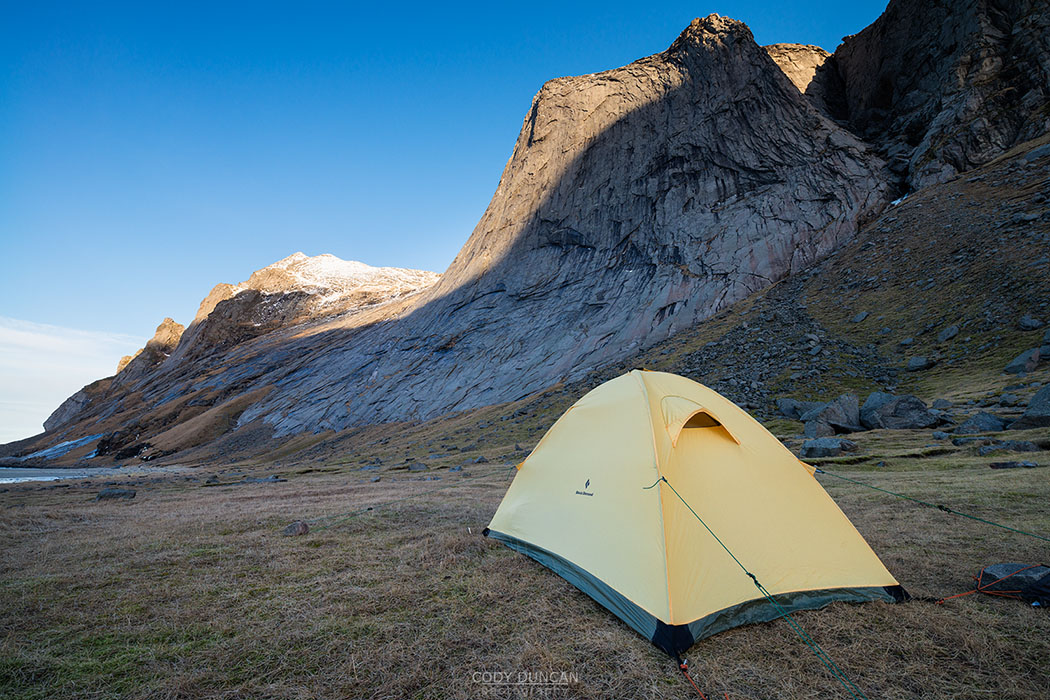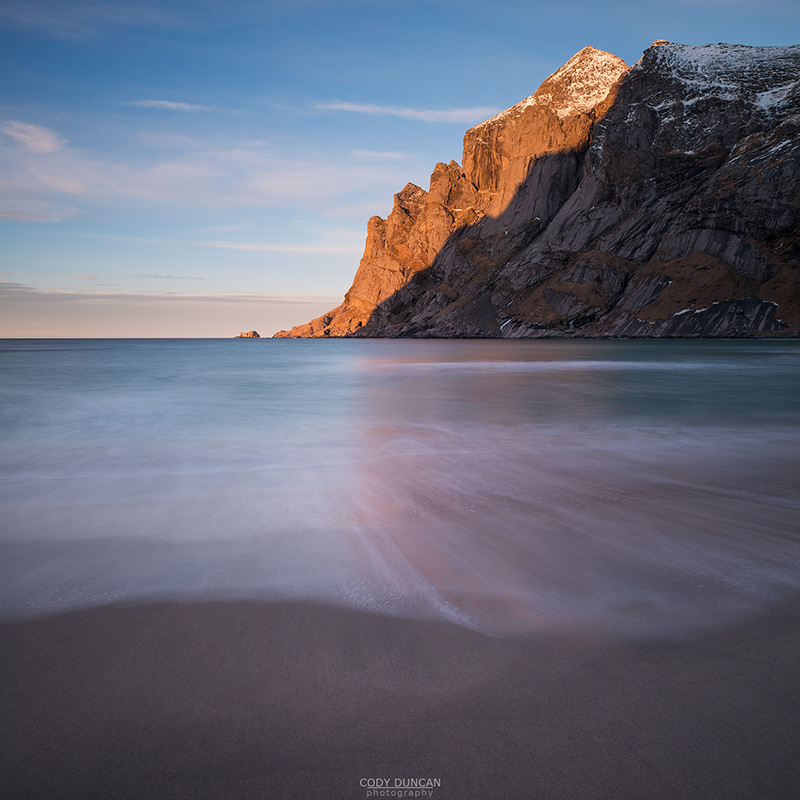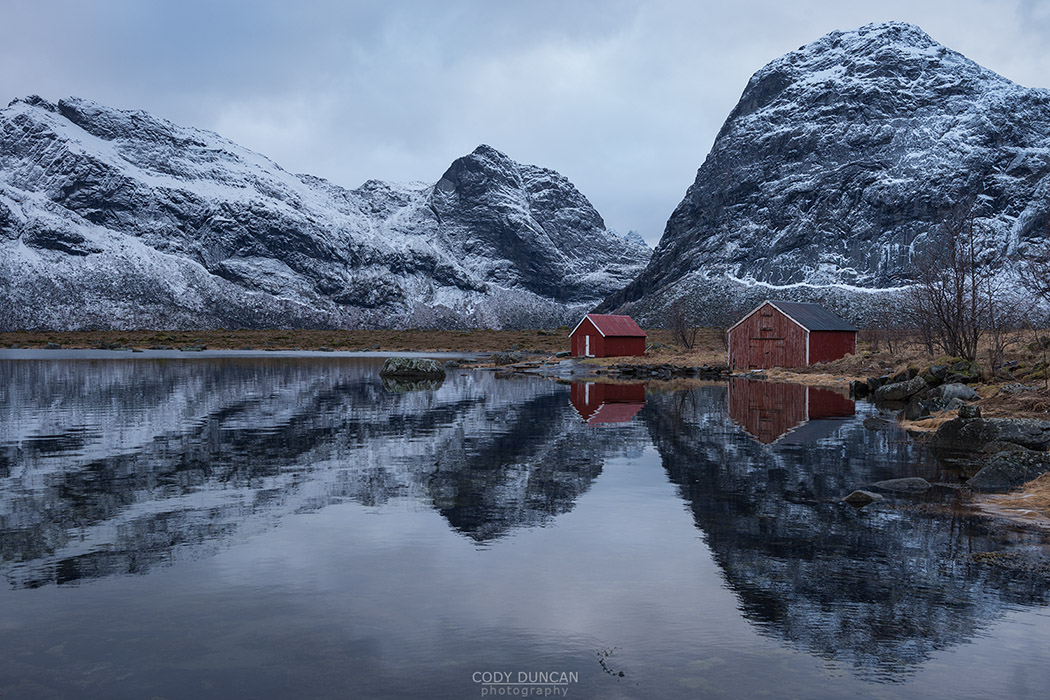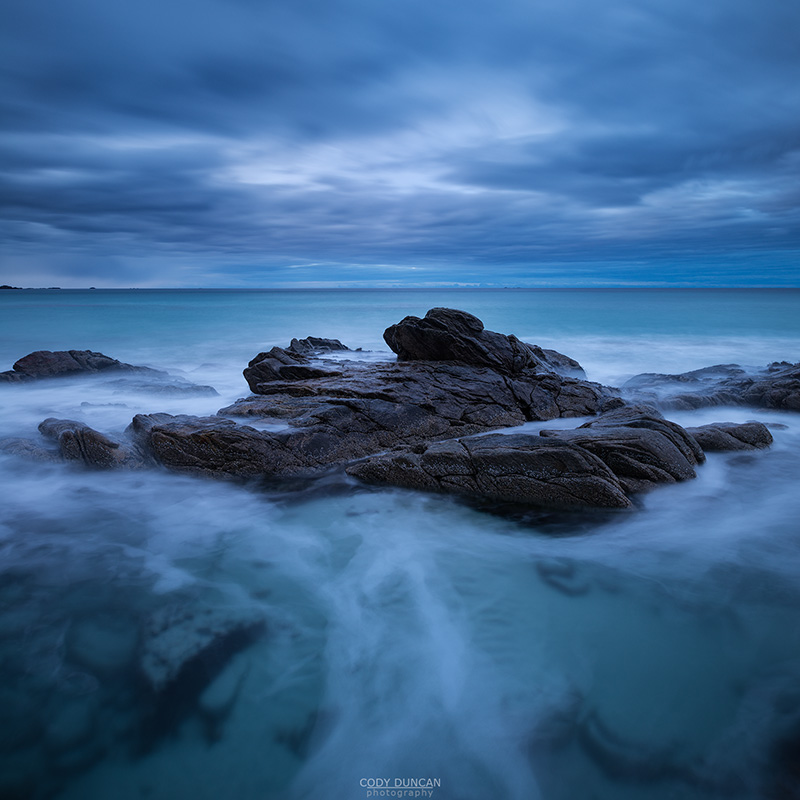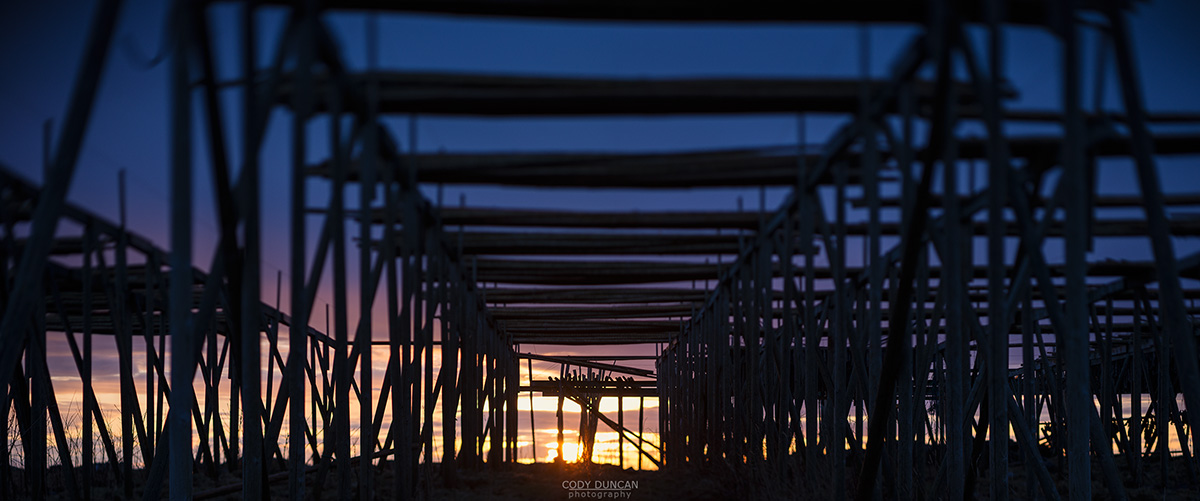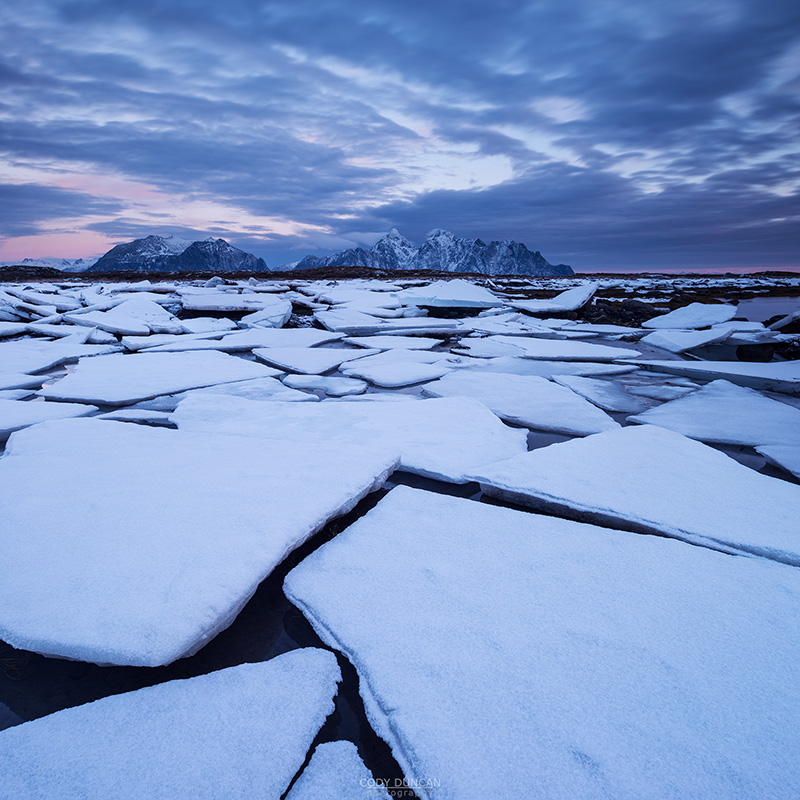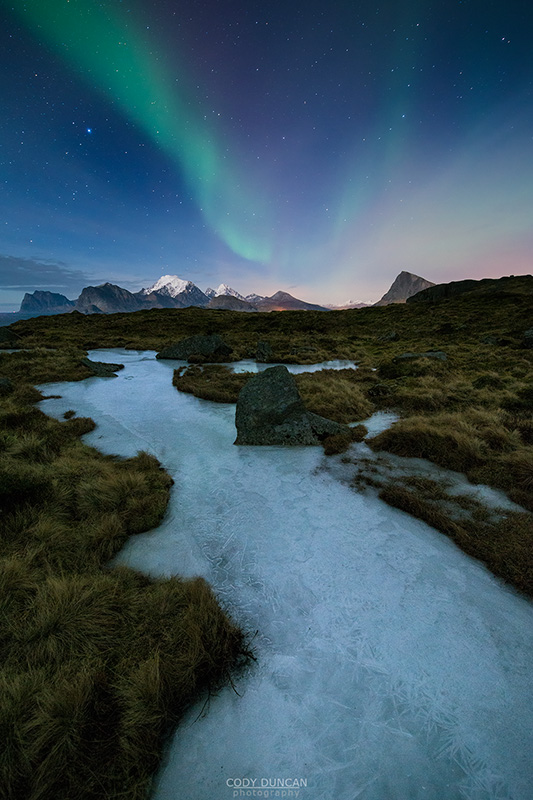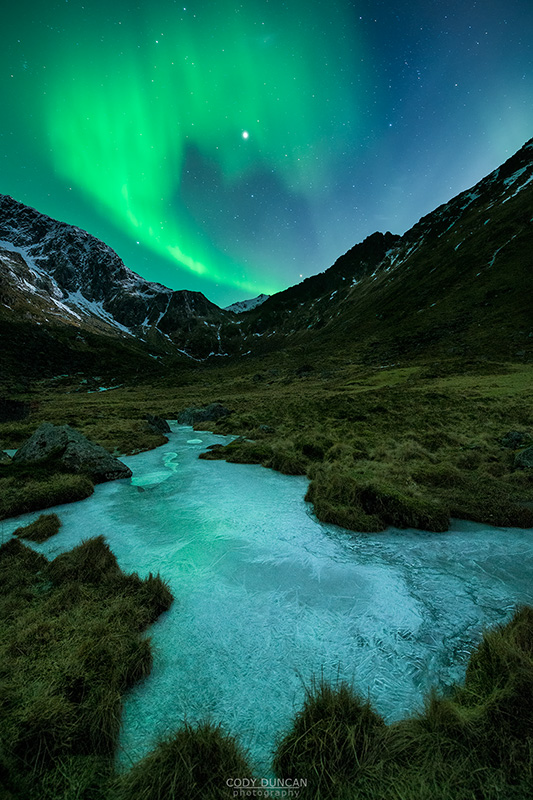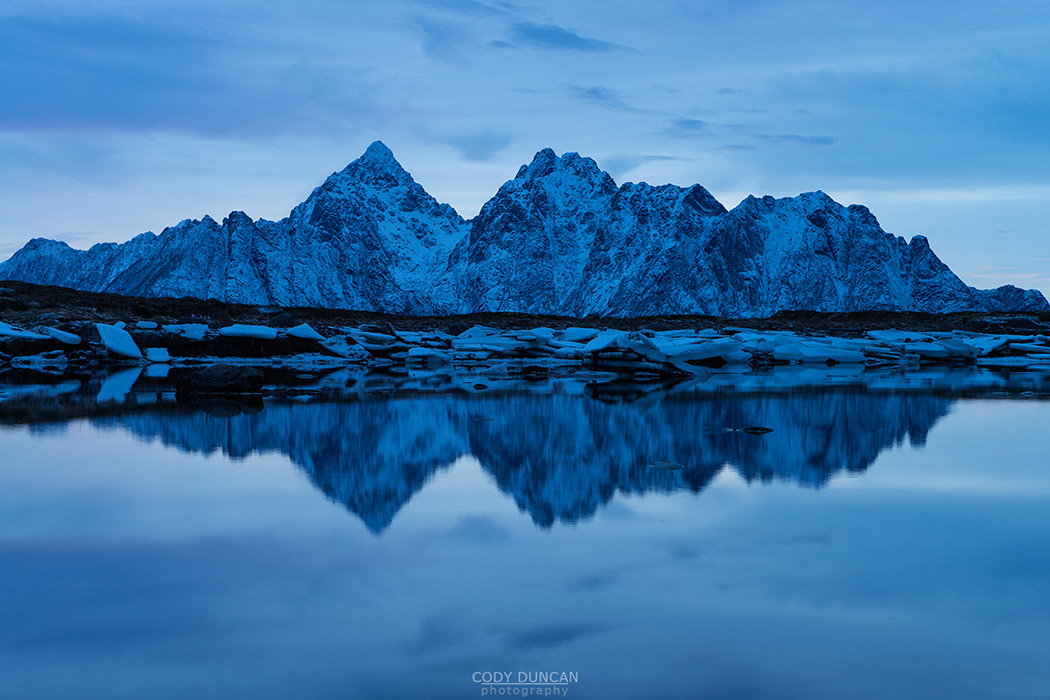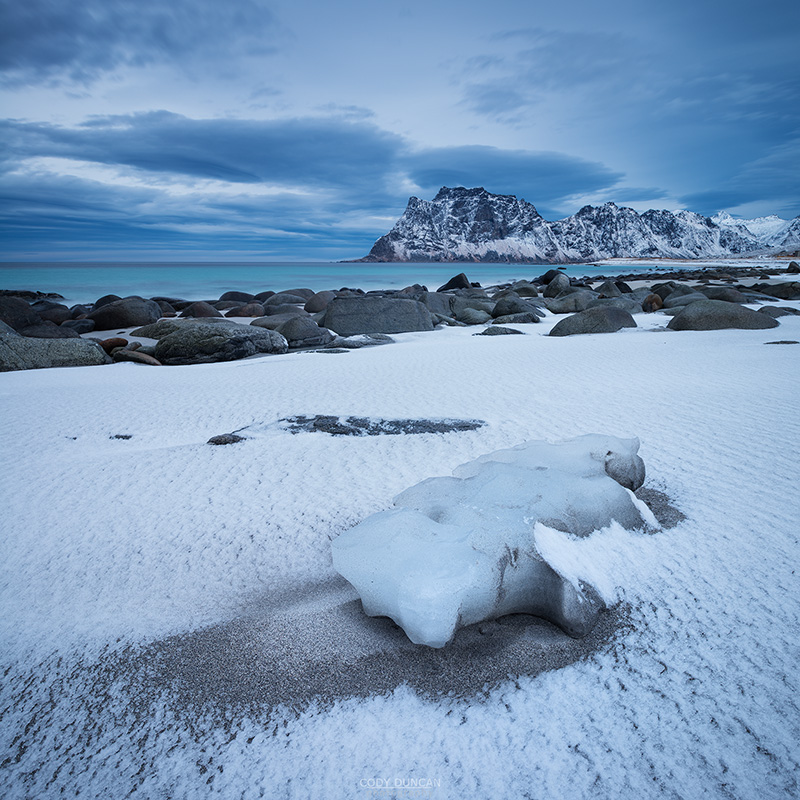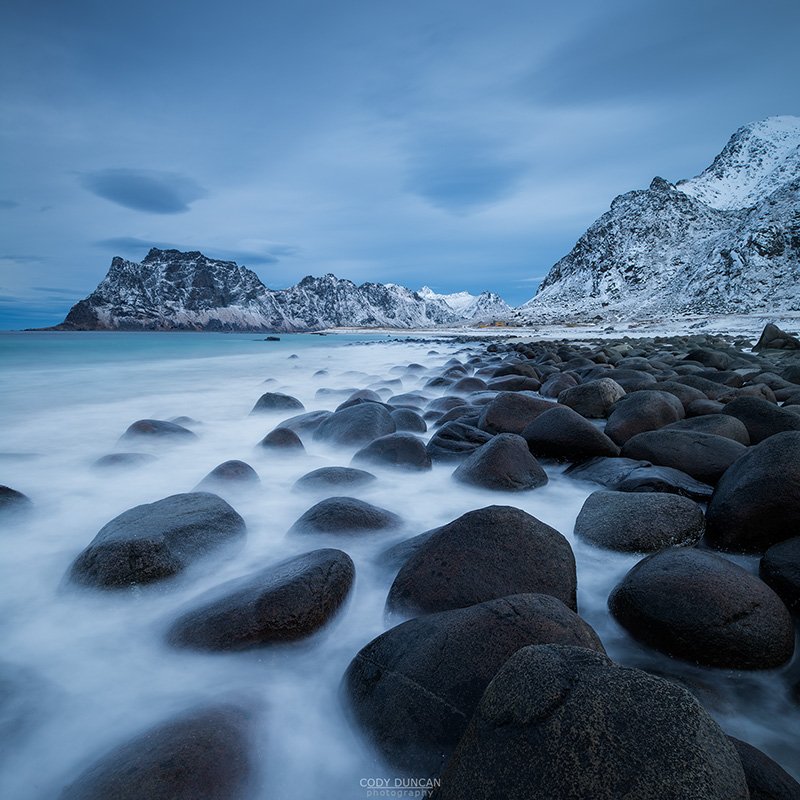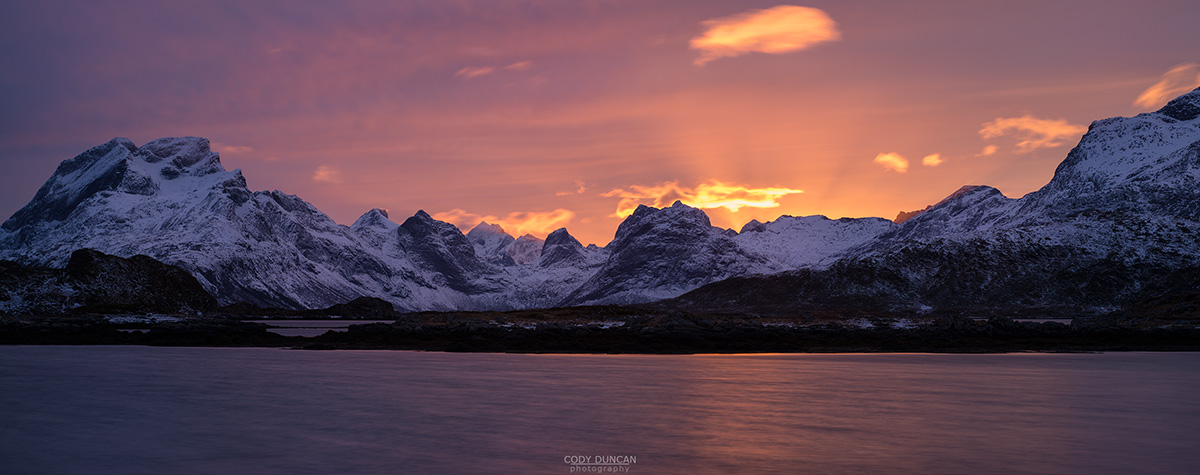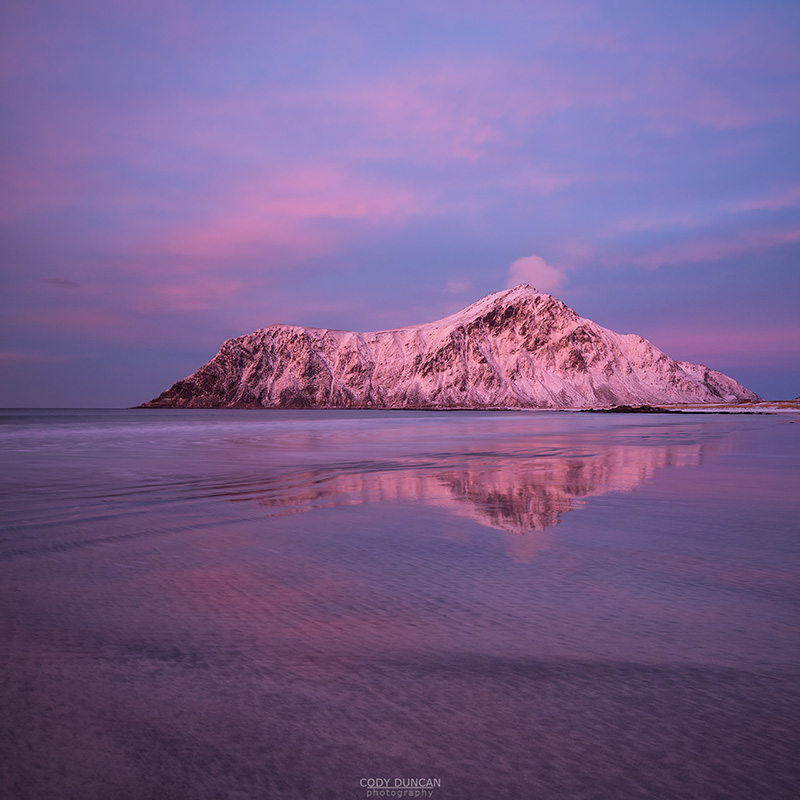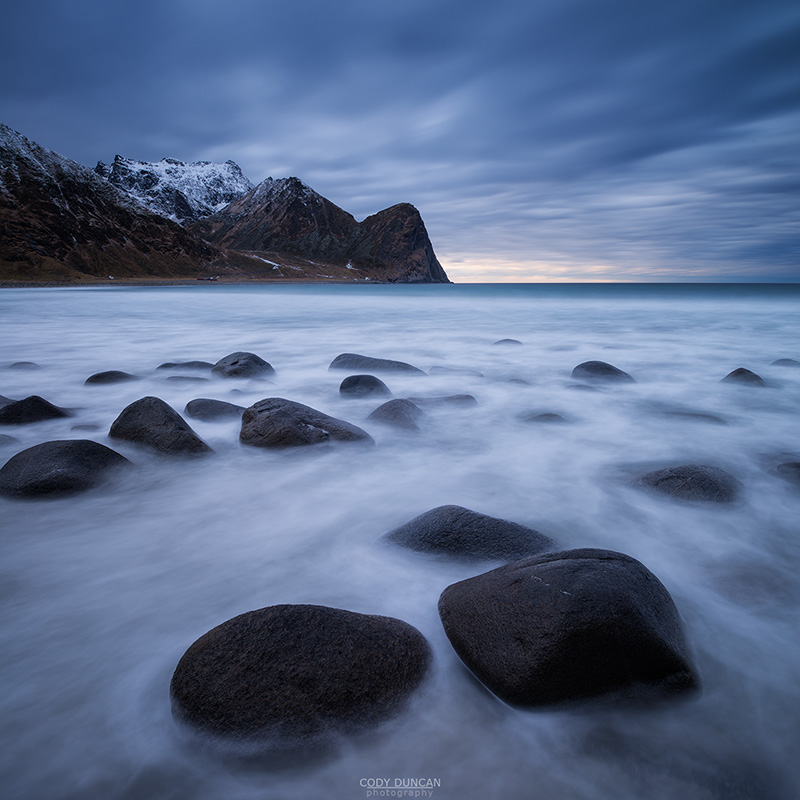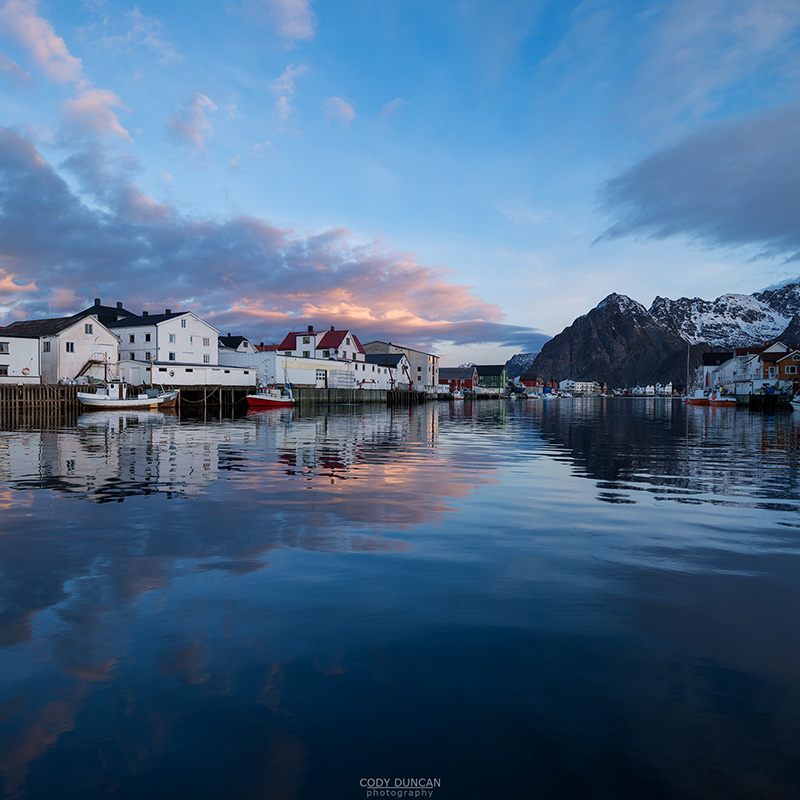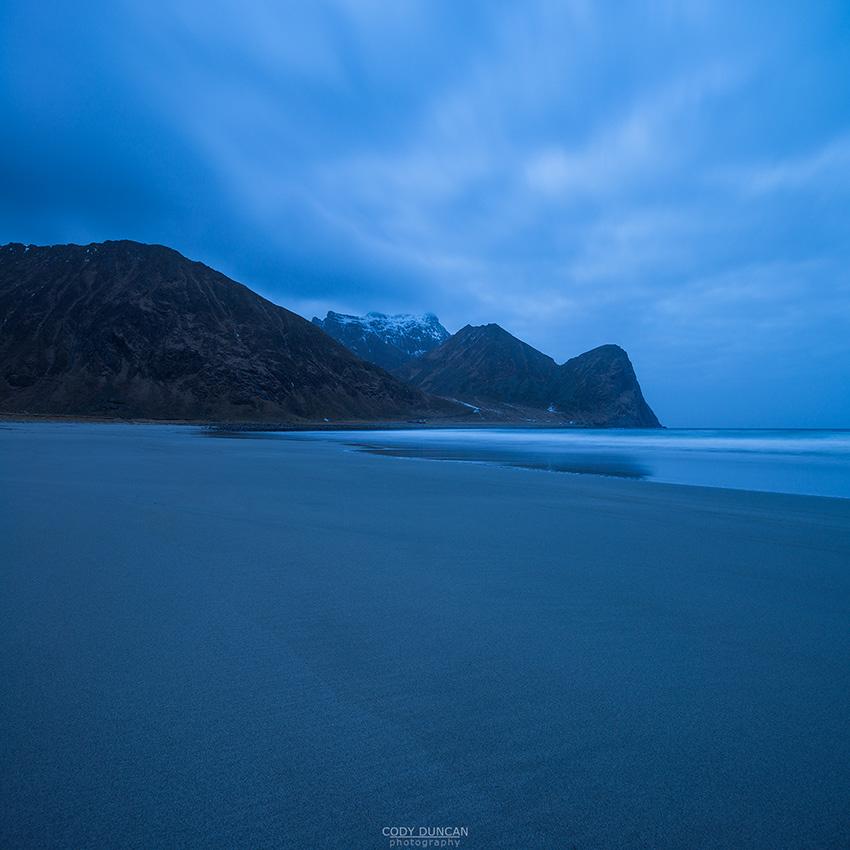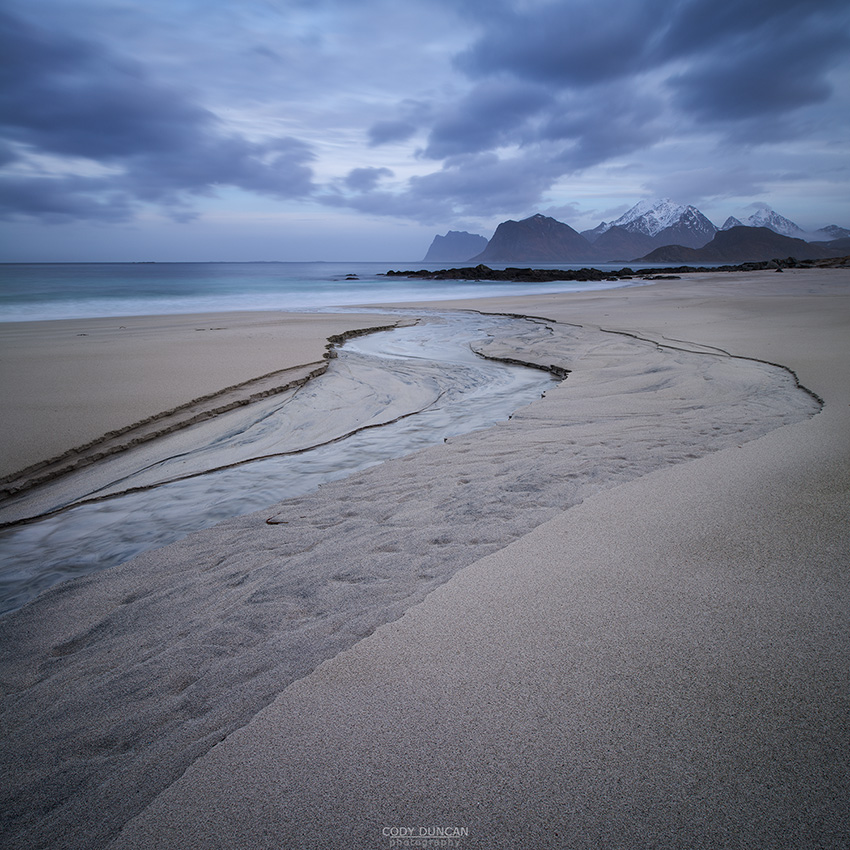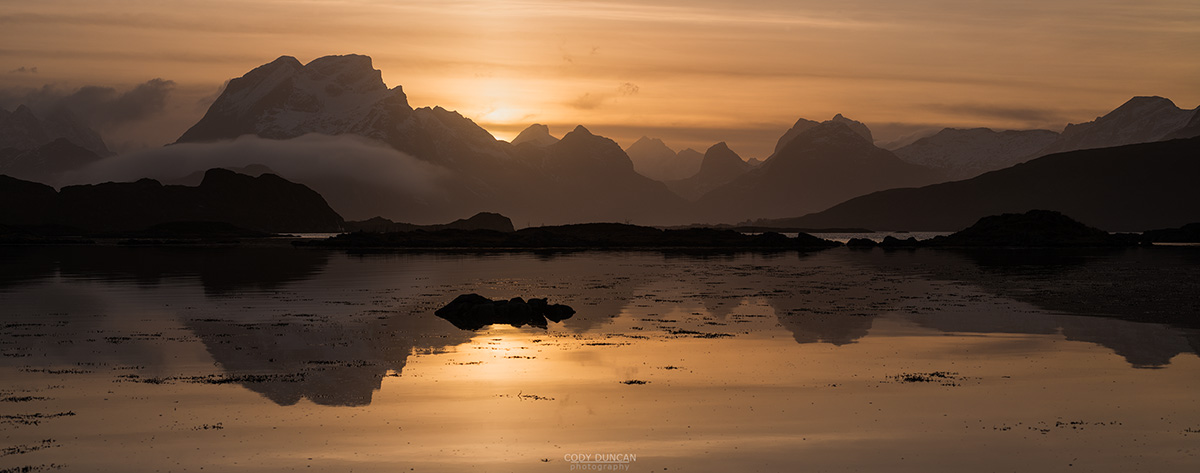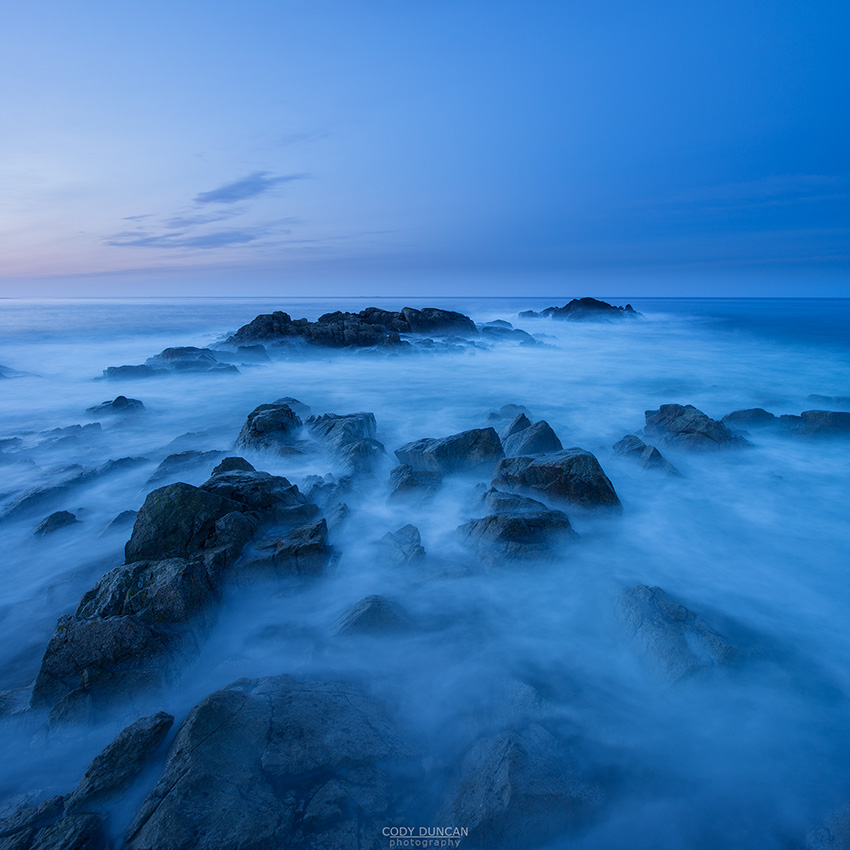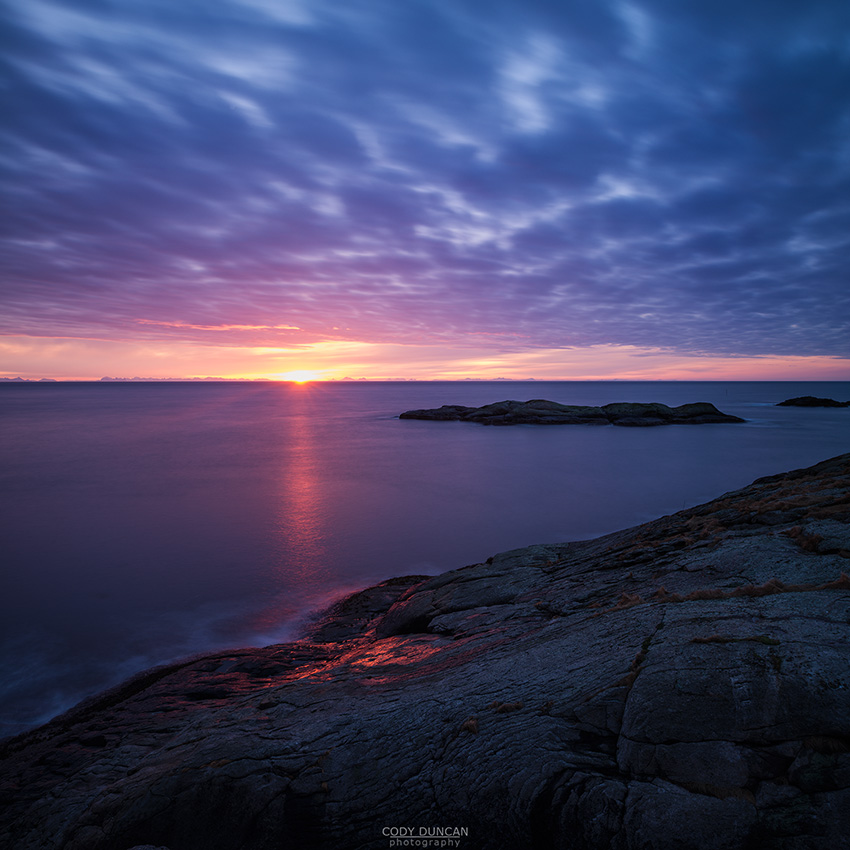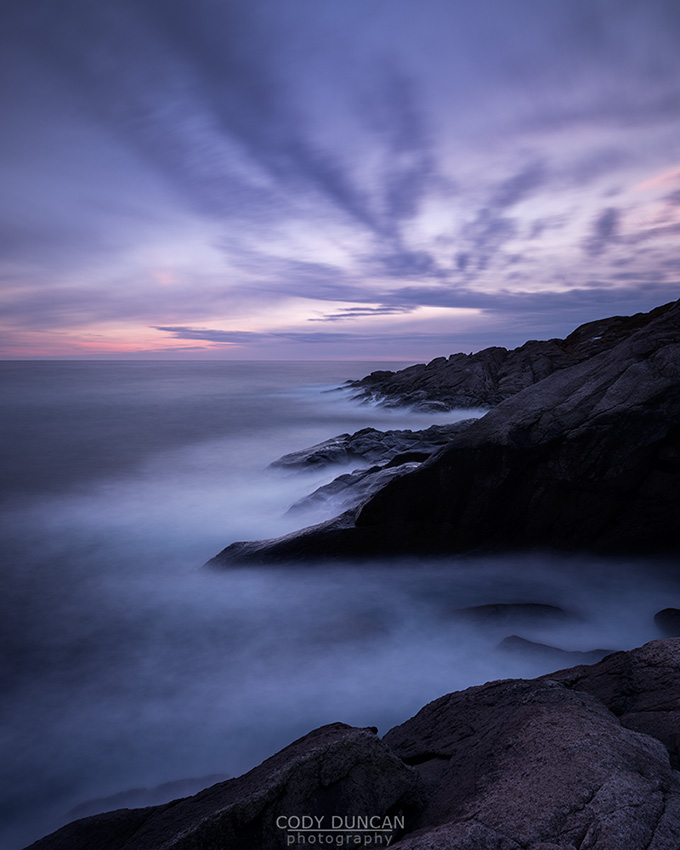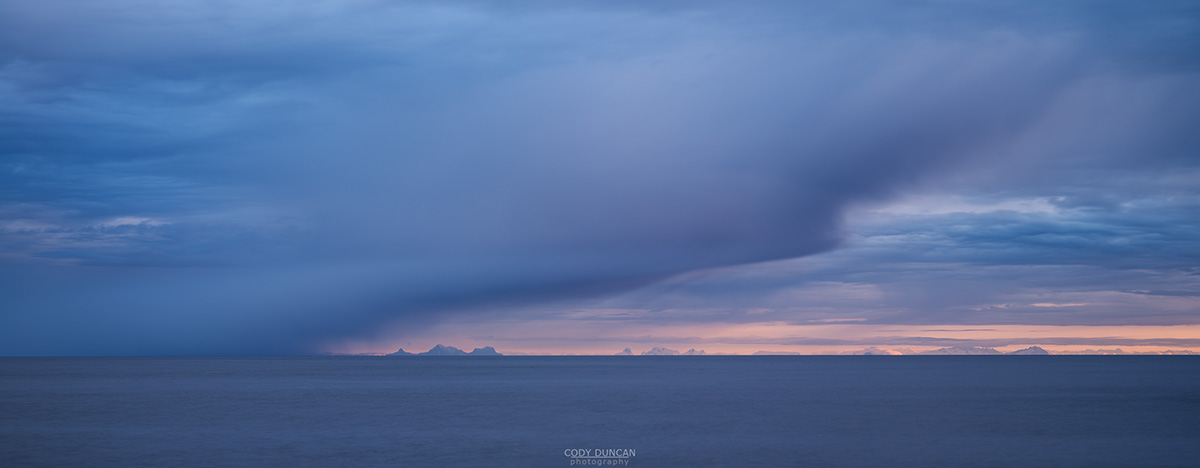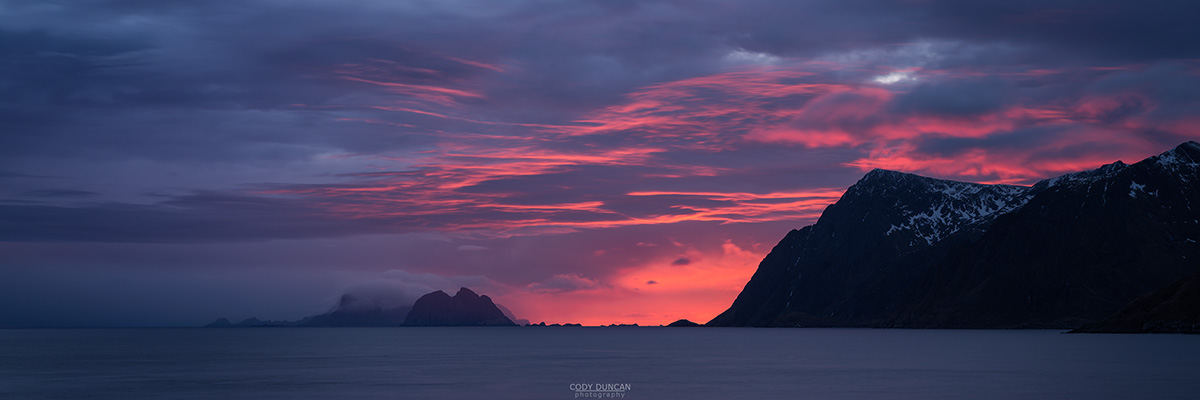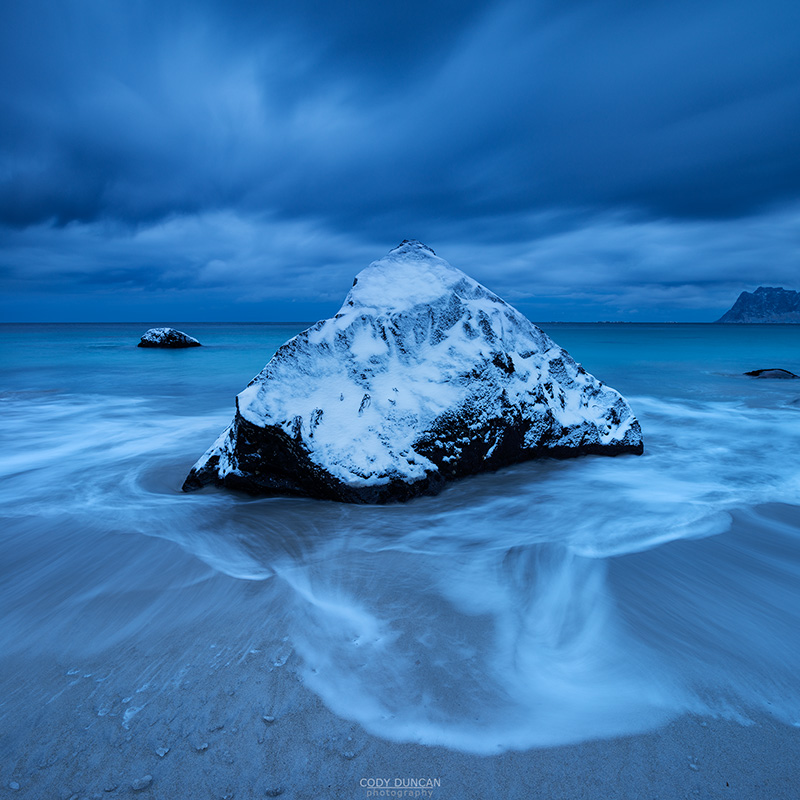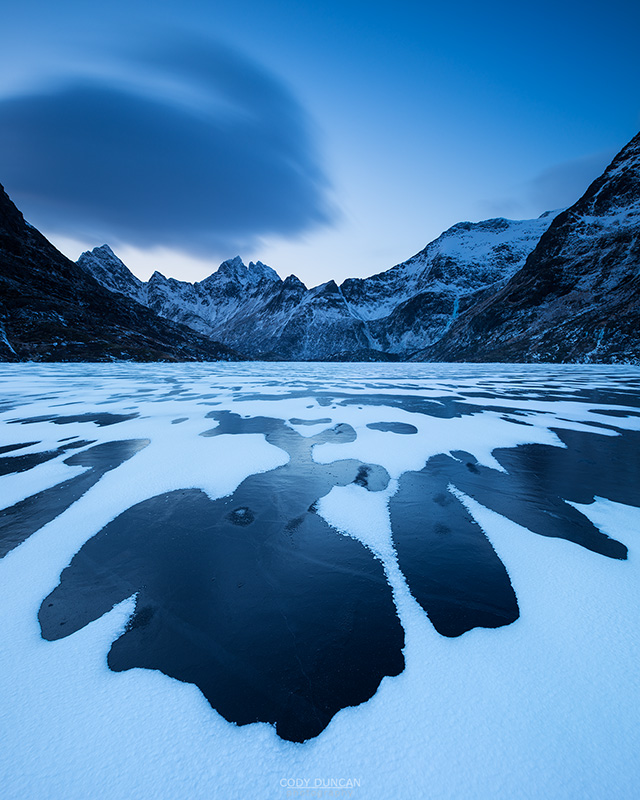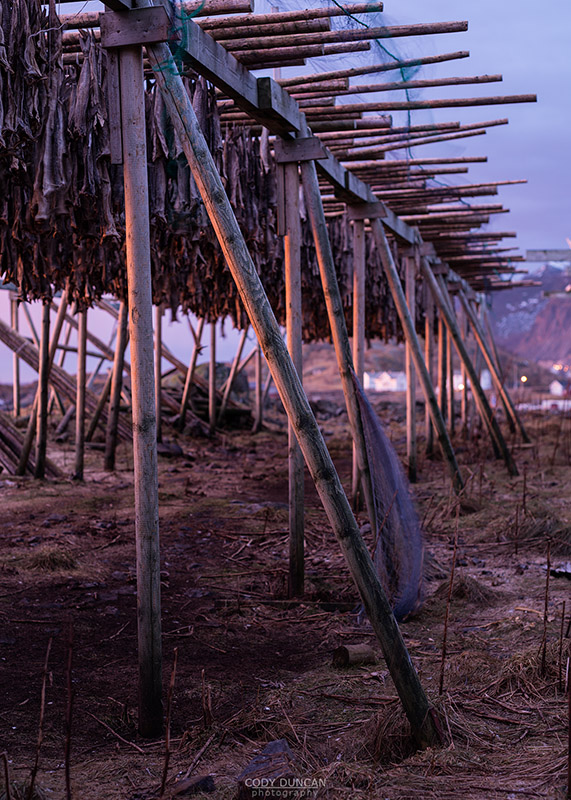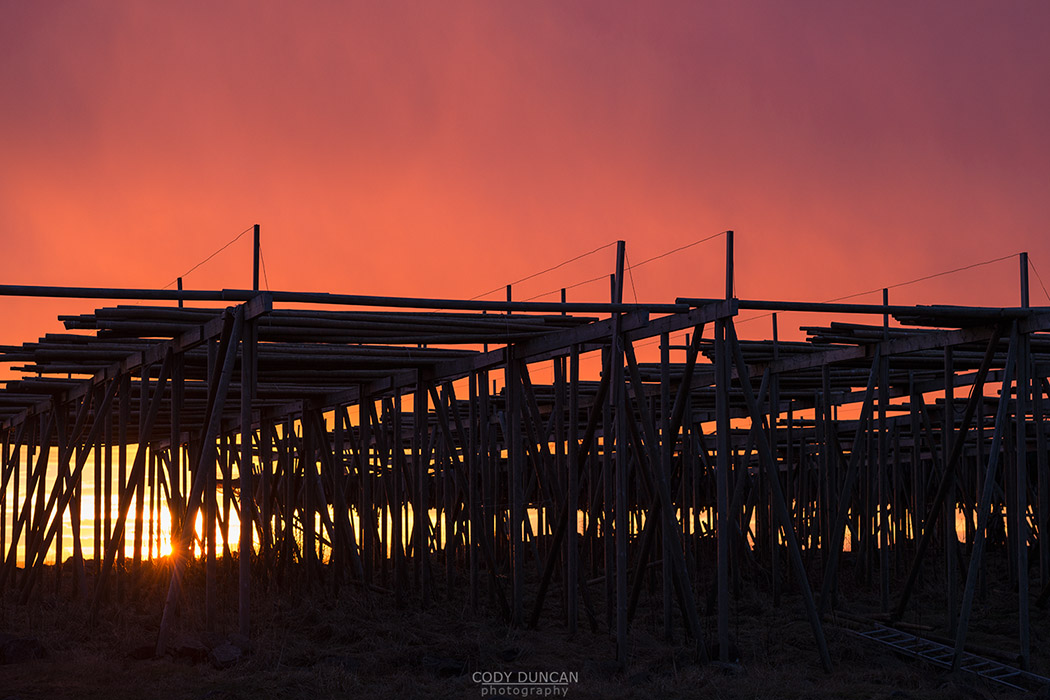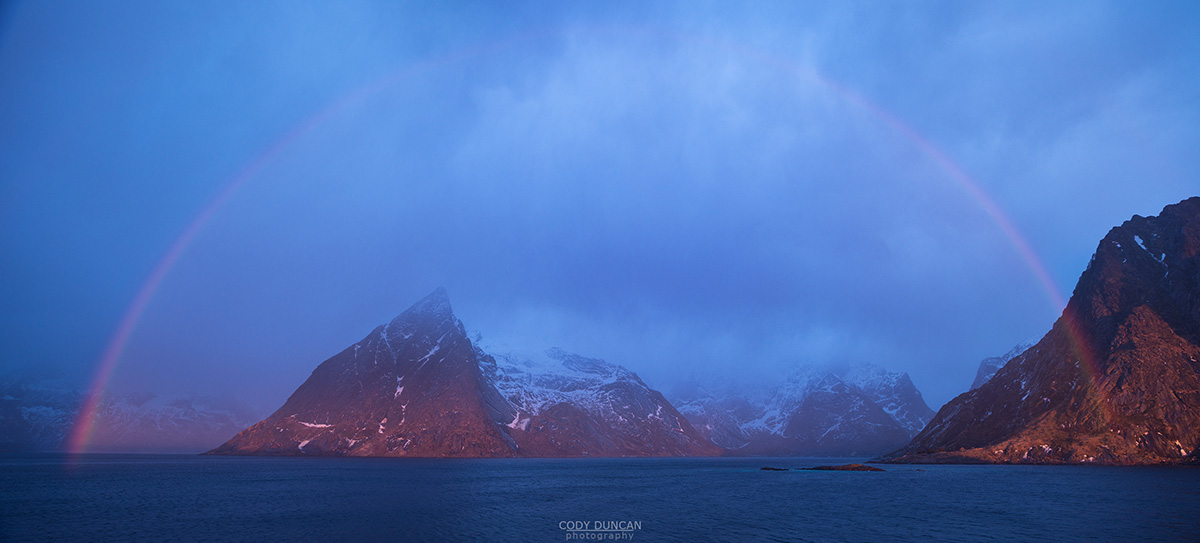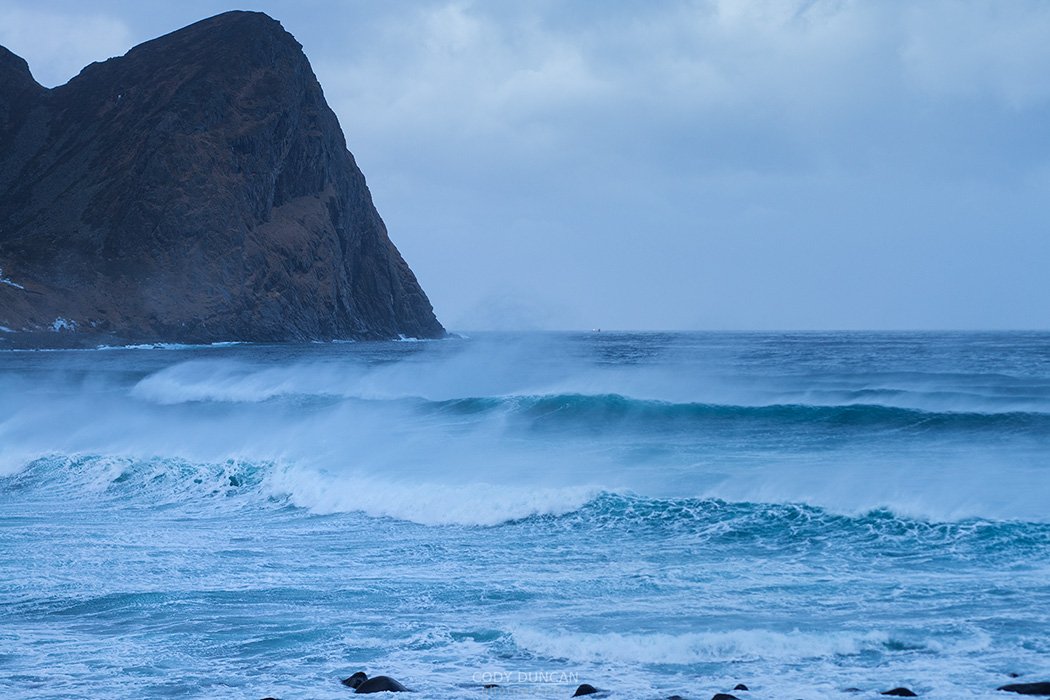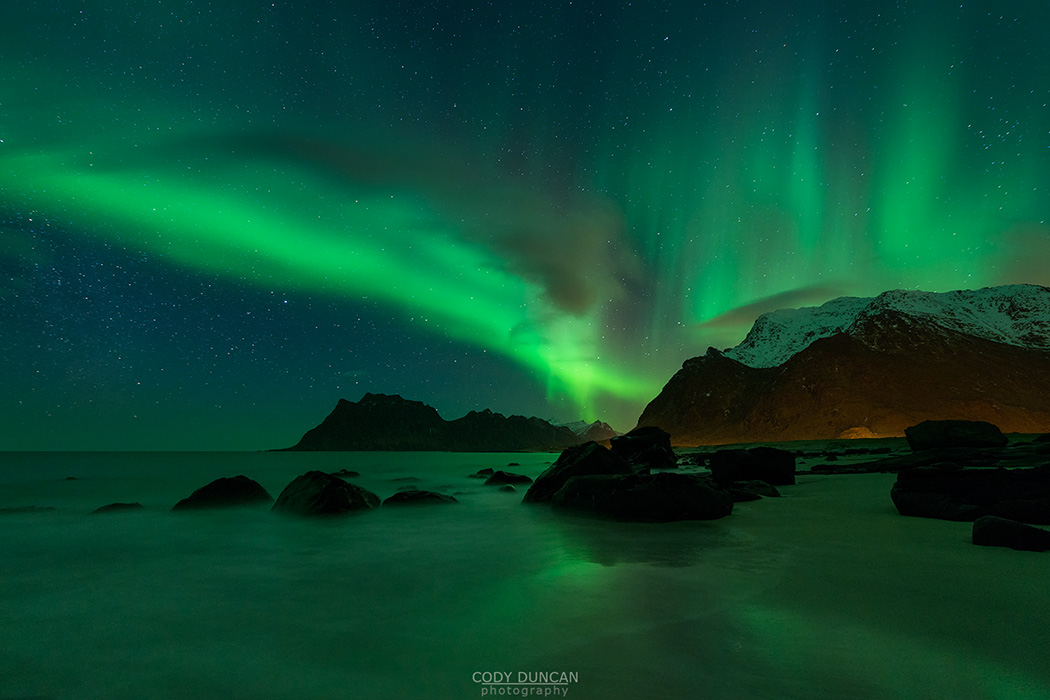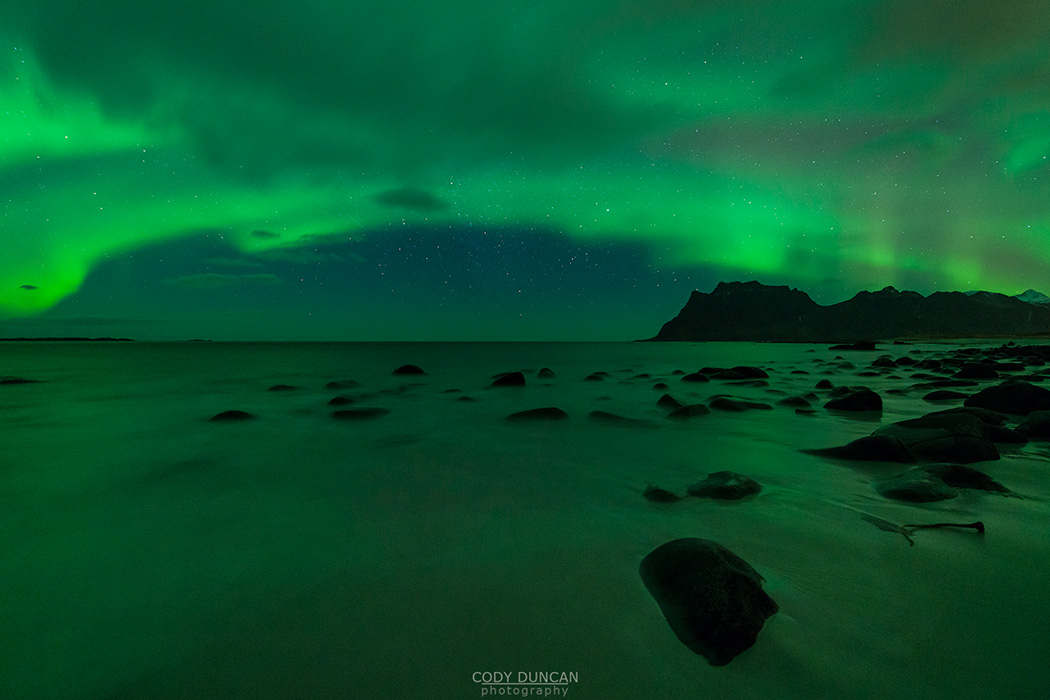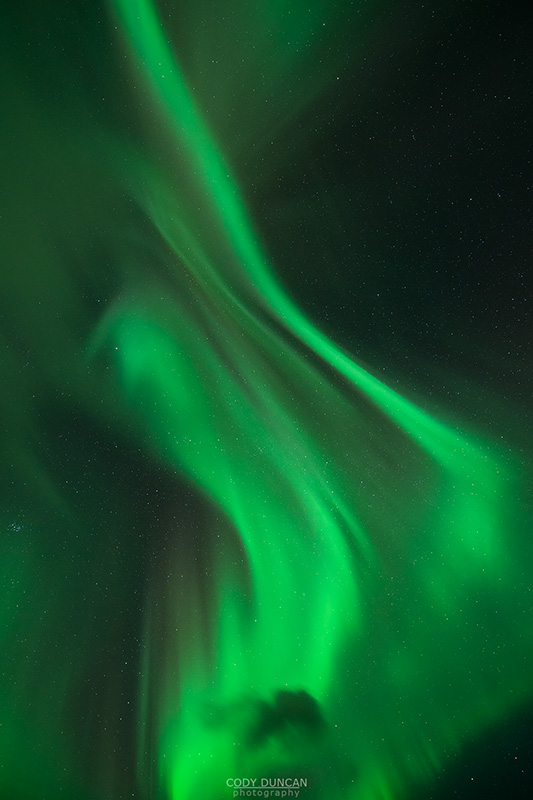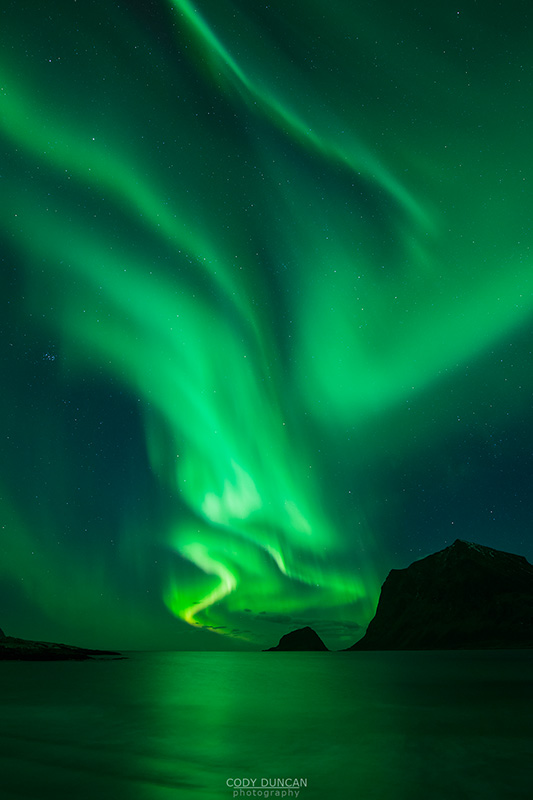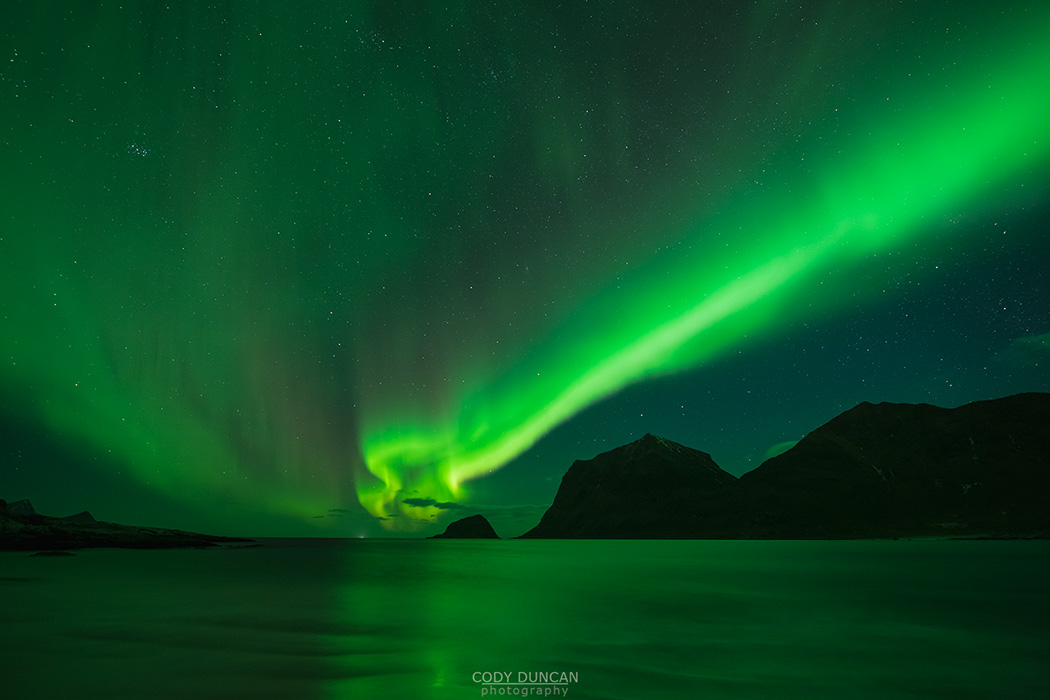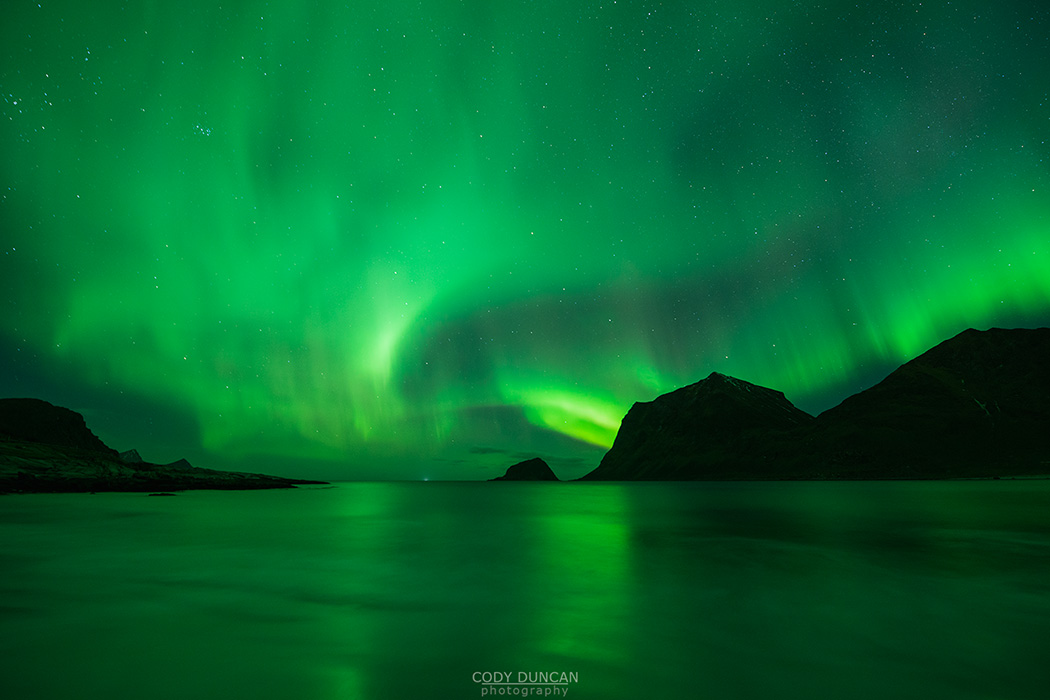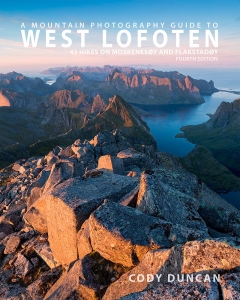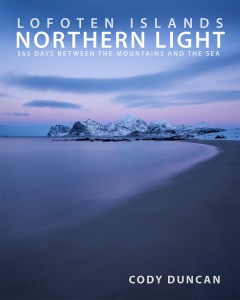— Here is a bit of a summary of my February Lofoten trip. I posted it on my photography blog a few days ago, but figure I might as well put it here too. And if you’re interested in keeping updated on things, be sure to checkout my Facebook page, I tend to start adding a few photos there as I’m in the process of editing and before anything is organized enough to add here. Anyhow, here’s 3,500 words. Happy reading… —
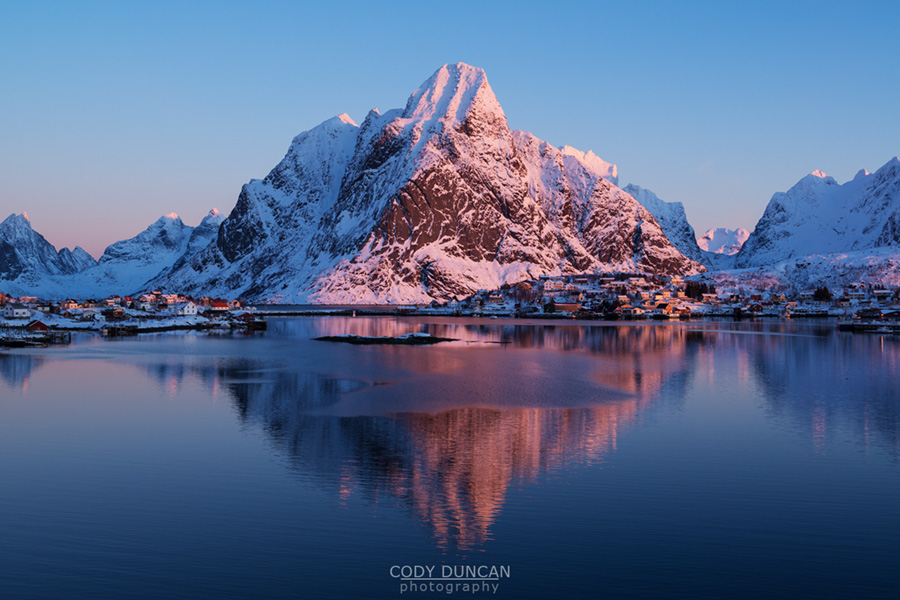
Photo: Pink winter sunrise on Olstind, Reine, Lofoten Islands, Norway. Feb 2013
After a 4 hour drive from Wales to a hotel near London’s Gatwick airport our stomachs were hungry for one last meal before flying to northern Norway the following morning. Bringing our bags to the room I noticed something missing, my pack of clothes I was planning on wearing on the plane, having just worn some old clothes for the drive, and wanting to start off as fresh as possible for the shower-less week(s) that would follow. Frantically searching the car, it was nowhere to be found. The contents of the missing bag (later found to still be sitting on the bed): Shell jacket, fleece, winter soft-shell pants. Key items to my warmth for the coming weeks. I did my best to enjoy one last meal in the pub, but my mood was soured by my stupidity; I never forget things.
After pulling out of the hotel at 6am the following morning for the short drive to the airport parking lot I noticed the car feeling a bit funny. Hmmm. Stopped at a light, I even quickly opened the door to try and get a look at the tires. But as it was only 1 mile from the hotel to the parking lot, I continued on. Getting out of the car at the drop off area, one of the workers came up and asked if I knew the rear tire was flat. Shit! With a plane to catch, there was nothing that could be done now. We were not even out of the UK and the trip was not exactly off to a good start so far.
An uneventful 12 hours of airports and airplanes put us north of the Arctic Circle in Bodø, just a ferry ride away from Lofoten. My mission now, with only 45 minutes until stores closed at 8pm, was to get into town and maybe, hopefully, find an affordable jacket of some sort. We hurried as fast as possible through the icy winter streets to Bodø’s center. First however, I needed to stop off at an atm for a bit of cash to pay for the rental car on the following day. In my haste I ended up at the ‘Valueta’ atm, right next to the normal one. I noticed something was odd when it asked me for the amount to withdraw in US currency, but in my distracted and rushed state, I proceeded. Moments later $300 US in crisp $20’s popped out of the atm. Ahhhh Hel! Now I was worried that my bank wouldn’t let me pull out money the next day, thus I’d have nothing to pay for the car with.
Finally arriving at the Intersport sports shop with about 20 minutes to spare I actually had a bit of luck and found a nice jacket at 50% off, making me the proud new owner of a ‘Too Blue’ Norrøna Falketind jacket. Although a good deal by Norwegian standards, it is still the most expensive jacket I’ve ever bought and I would have rather skipped the expense. Though it is a pretty sexy jacket, so I’m sort of only half grumpy about it. But, to continue the trend of the last 24 hours, I wouldn’t be allowed to leave the store without a bit more bad luck. This time, and for whatever reason, I forgot the camping gas that I had also purchased. I thought the clerk had put everything in the bag, but it must have stayed on the counter, only for me to discover it missing several hours later while sitting at the ferry waiting room. I was now beginning to feel like a walking disaster.
Last year on my February Lofoten trip, I somewhat annoyingly found out that the ferry waiting room is now closed at night during the winter months, stupidly spending an evening outside in the cold huddled up in my sleeping bag when I should have called the number on the door, that said to call it, which would have let me in. This time I called up the harbour office straight away and we were soon out of the cold. Over the years of spending many a night in the waiting room on my way to and from the islands I’ve heard various stories about various miss happenings at the place, ranging from drinking and drugs to prostitution, though never witnessed anything strange myself. First they added the CCTV cameras a few years back, but it must not have been effective enough, so now they take to locking the doors during winter.
After dinner of bread and butter, we sat around counting down the hours until the 01:30am ferry that would take us to Lofoten. Sometime after 10pm I heard some banging on the doors, followed by some drunken sounding yelling and cursing and then more pounding on the doors. A man was there, sleeping bag in hand, yelling at the door and kicking it. Uh oh. We tried to ‘play asleep,’ but it didn’t seem too effective. He moved around to the other door where he could get a better view of us just sitting there, not quite knowing what to do. Soon the insults were directed at us, along with various threats about stabbing and shooting, and request to ‘Wake up! Let me in! What, are you scared of me?’
The shouting and banging continued for several more minutes as the man went from door to door. Needles to say, I’m glad the doors were locked! I sort of hid in a corner, out of site, and made a call to the harbor office. They said they could see what was happing and that the police would be by soon. And not to let him in! A few minutes later, the harbor office called me back, letting me know the police were now outside. One of the officers stayed outside talking to the man, while another came in and chatted with us. We were informed that the man was ‘known to them.’ Something a local drifter that doesn’t take offers of help. I’m not sure if he was drunk or on something else, but my guess would be yes.
After about 15 minutes of the police talking to the man, he seemed to be off on his way back into town and the police drove off. I’m not sure what ever happened, but at least we were left in peace the rest of the night. I was also hoping that no one else showed up, as I wouldn’t have been sure to let them in or not. Finally, 01:30am arrived and we were bound for Moskenes on the almost completely empty ferry and another couple of magical weeks of winter on the Lofoten Islands.
Normal people would fly, and we probably should have too. But initially we weren’t sure if we would immediately rent a car, or maybe spend a few days hiking and camping around Reine. But as the day of our arrival on the islands came, and combined with the weight of our packs full of climbing gear, not to mention other crap that I needed to bring back to California at the end of the trip, picking up a car right away was deemed the best option.
Luckily I’m sometimes smart, or at least partially so. In my great wisdom, and cheapness, I purposely chose the Wednesday ferry, because instead of going directly to Moskenes, about 4 hours sailing, it first stops at Værøy. Stopping at Værøy adds another 2 hours to the journey. And that means 2 hours more sleep, almost 6 hours in total, often times my only chance at rest for 48+ hours of travel to the islands. Though I usually tend to find someplace to crash out early on my first night. Last year in August, after catching another ferry and hiking out to Horseid beach, I was sleeping by 3:00pm as it was raining anyhow and unlikely I would miss anything interesting.
I’ve written and complained about this before. That for such a (often) cold place, with marginal weather at best, there is shit-for-all places to wait if relying upon public transport. In Moskenes at 06:00am, the best place happens to be in the small hallway outside the toilets, which luckily, are open 24 hours. In February last year, I made the mistake of walking to Reine instead of waiting in Moskenes, where I sat 2+ hours in the open wind at -5˚C while waiting on the bus. I learned my lesson, keep warm, and dry, in the toilets. And ignore the odd looks of any stray people who might stop by for some relief.
Originally planning on catching the 09:00am bus, we caught the one at 06:40 and rode to Leknes with all the half, or fully, asleep teenagers on their way to school. I feel sorry for the poor kid living in Å, that’s a long way to go each day! I hadn’t scheduled the car pickup from Stamsund until noon, so we killed a few hours waiting in the mall, the only heated place in Leknes at that time of day where you don’t have to buy anything. I also needed to wait until it was past midnight back in California, 09:00am in Norway, so I could try and take the correct currency out of the bank this time. Fortunately I was successful.
And in a bit of a turn in my luck, and the savings of a couple bus tickets, when I called the car rental guy, he happened to be in Leknes as well and could take us to Stamsund. I guess that canceled out the cost of my lost stove fuel. Now how to make up for the forgotten jackets? Maybe I just need to take some decent photos that will sell…
I knew to request a large car this time, as it would be home for the two of us for the following week, and then just myself for another week after that. And so shortly before noon I was cruising in style in a mid 90’s Toyota Carolla wagon. Doesn’t get the best gas milage, but at least I can fully stretch out in the back.
Driving in Norway in winter is a unique, and sometimes frightening experience. When temperatures are cold, they don’t fully plow or grit the roads, just make a compact layer of hard snow, and clear away any excess. With the Norwegian studded winter tires, this is no problem to drive on, probably 75-80% traction compared to normal roads. The scary part comes when the temperatures rise to a few degrees above freezing and it begins to rain. Then you’re driving on a sheet of wet ice that is slipperier than anything known to man and even the Norwegian tires struggle at times.
And then comes parking, or attempting to park. Most of the normal roadside pull outs are covered in snow, as they are left unplowed. I have most pullover places, or at least the decent photo location ones, memorized, but then comes the risk of pulling out a bit too far into that side of the road extra hard and compacted snow and getting stuck. If I’m successful at anything in life, it is this process. Though luckily I’m also pretty successful at getting un-stuck. But the lack of parking does leave a bit of a dilemma for winter photography. Do I just pull over, still with enough room for passing, and figure I’m on some sort of important mission and not concern myself with blocking the road. Or do you drive on by, and miss a potentially scenic scene? I guess it depends, and I tend to do a bit of both.
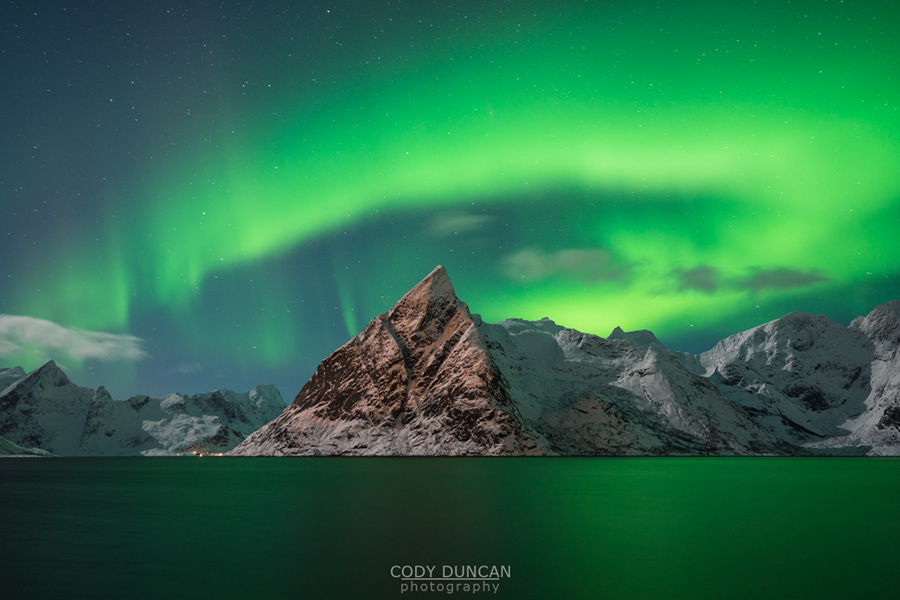 Photo: Northern Lights fill the sky over Osltind, Lofoten Islands, Norway. Feb 18, 2013
Photo: Northern Lights fill the sky over Osltind, Lofoten Islands, Norway. Feb 18, 2013
Last year, 2012, I spent over 2 months north of the Arctic Circle: about 6 weeks on Lofoten and 2 weeks in northern Sweden hiking the Kunglseden trail. While the purpose of my travels wasn’t exclusively to see the Northern Lights, I wouldn’t have complained if I was able to photograph some good displays. In my February 2 week trip, I simply had bad timing, with large Auroras both several days prior and after my time on the islands. I saw only one small display over those two weeks. In the latter half of the year, the skies were mostly quiet, even on numerous clear nights. That was until the night of Oct 8, my departure from Lofoten. As I was walking from the hostel to the Hurtigruten ferry at 9:00pm at night, I could feel it. I knew something was going to happen. And by the time the ferry was departing the dock at 10:00pm, the perfectly clear night sky was beginning to explode with color. I even thought about getting off the ferry and maybe trying to catch an early flight in the morning, but eventually decided against it. And had I been on one of the newer boats, I would have at least attempted to make a few photos. But alas, I was on the second oldest boat of the Hurtigruten fleet, with only a small outside deck area which is not very conductive to night photography. And so I watched, almost crying, for hours as the sky was filled with light from horizon to horizon. Epic, amazing, beautiful, and a whole host of other words that I’d have to look up in the thesaurus to expand my vocabulary. And why I love the North so much. If only I had a little better timing sometimes…
February 2013 was that better timing. On my second night on the islands, Valentines day, I was at Utakleiv to photograph a decent display. If that was all I had seen, I would have been happy. But then again, a few days later while down at Reine, the sky erupted for almost an hour, allowing me to get close to my long envisioned ‘Aurora over Olstind’ photo. And again, the following night once again, this time at Vik beach, a short but sweet display of the lights. Three times in one week, any of which alone I would have been more than happy about!
I hope to avoid sounding like two old ladies in the supermarket, but its time to talk about the weather. The weather more or less decides how photogenic any trip to Lofoten will be. And unfortunately, there is absolutely zero predictability. This doesn’t help much when having to plan months in advance and having to fly halfway around the world. Actually, if I were to give a general comment on the weather, it would be that two consecutive seasons are rarely the same. That is to say, if you hear that the islands had great weather all summer, such as the summer of 2009, do not plan a trip for the following summer, as it will likely be bad, such as the summer of 2010. On the other hand, poor weather in one season can often result in better than average weather in one of the other seasons.
With the unpredictability of the weather, I believe it’s best to give yourself as much time as possible on the islands. For me this usually means about two weeks. Longer than that and I start to remember how expensive Norway is; there are only so many $100+ gas fill-ups I can take before my credit card starts to protest. Two weeks are usually enough time for you to at least have a couple days of good conditions, even if the overall trend is poor. And if the weather is good, then all the better! For example, arriving on February 13th this year, my first week was better than average. Had I stayed only one week, then I would have been completely happy with the images I produced. After February 20th, conditions deteriorated, with consecutive days and days of rain and warm (for winter), snow melting temperatures. Had I arrived on the 20th, then I would have been fairly disappointed by the conditions during the following week. But when I booked my tickets in December, there was no way for me to know which week to choose. At the end of the day, Lofoten’s weather is all just luck and a gamble, so try and hedge you bet by allowing as much time as you can afford. And try not to be jealous of someone who only spent a few days on the islands and returned with a beautiful set of images, they’ve obviously figured out a way to bribe the weather gods.
By day 4 of sitting in a car while watching the rain and wind outside, I find myself struggling against boredom. One of the benefits of sleeping in my rental car is that I can pretty much stay wherever I please. The drawback comes at the hours, or days, when waiting out bad weather. I find myself tempted by a bright spot of light in the distance, or maybe there might be better conditions over in Reine. But I know the islands and myself well enough by now, and not too chase pots of gold. It takes all my effort not to spend the day driving in circles chasing the ‘what ifs.’ It’s best if I just park myself at somewhere like Eggum or Unstad for the day, and night, and try to imagine better days ahead, hopefully having the time to do so.
For this trip, I more of less could have skipped the 2nd week and returned with a similar collection of images. I carry 3 things with me than need batteries: camera, iPod, and laptop. By the end of the second week, my laptop and iPod were both out of juice, while I hadn’t even used up a single battery in my camera. But to repeat myself for the xx time, there is no way of knowing when you’ll have the good weather or suffer from the bad. Time on the islands is your only insurance unfortunately. Sitting around for a week with little to do while burning through money (rental car) is not the most desirable place for me; Lofoten images can come at a high cost.
It is always easy to spot photographers newly arrived on the islands, as they haven’t yet learned that its pointless to fight the elements here. They must think I’m a bit odd appearing as well, sitting in the back of my car half way covered by my sleeping bag for warmth and reading or typing away on my computer, if I’m lucky enough to still have a bit of power after several days without a charge. I, in turn, think they are a bit crazy as well. And when they return to their cars sodden wet 20-30 minutes later, I can’t imagine that the flat, gray light and tripod-knocking-over winds were worth it. But maybe I’m just lazy…
It is stormy days like these that, despite the cold, I’m glad I’m on the islands in winter as night, and sleep, is never far away. By noon, I know it’s only a few more hours until darkness comes and I can curl up in my sleeping bag for 15+ hours of restless sleep, sometimes the best way to pass the time I’ve found. maybe I need to invest in a power inverter and put a few movies on my laptop so not to feel like such a lazy bastard. Or, if I wasn’t so cheap, I would go look for a coffee shop, milk a latte for a few hours to get all my electronics up to full power, and then return to my quite parking stop at Eggum. But I’d rather suffer from boredom than spend 40nkr of a coffee that I probably wouldn’t even enjoy all that much.
And while I’m on the topic of quiet parking places at the end of long roads. What is up with the car that drives by at midnight on a stormy night, does a circle, then leaves? This seems to occur wherever I end up. Are they just local teenagers looking for a place to, uh, have some privacy. Random grumpy locals seeing who’s camping on their road? Or just some tourist who got lost on the way to their Rorbu? I don’t know, but I always get a bit paranoid when a pair of headlights wakes me sometime late in the night, more so because I’m often less than 100% legally camping.
For someone like myself who really likes wintry looking landscapes, but isn’t especially fond of the cold, the Lofoten Islands in winter are an ideal location. Or, as I like to say, the islands are not as cold as they look. Ideal conditions find the temperature hovering just a few degrees below freezing, with a layer of snow covering everything from the highest peaks to coastal rocks lapped by waves. But this is a fragile balance, and throughout the winter periods of warmer weather and snow melting rain sweep across the islands, bringing a near overnight transformation for a snowy winter wonderland to a soggy brown landscape.
The one counter to the (relatively) mild winter temperatures is the wind. I’ve never experienced a wind before that has such an ability to suck the heat out of you.
